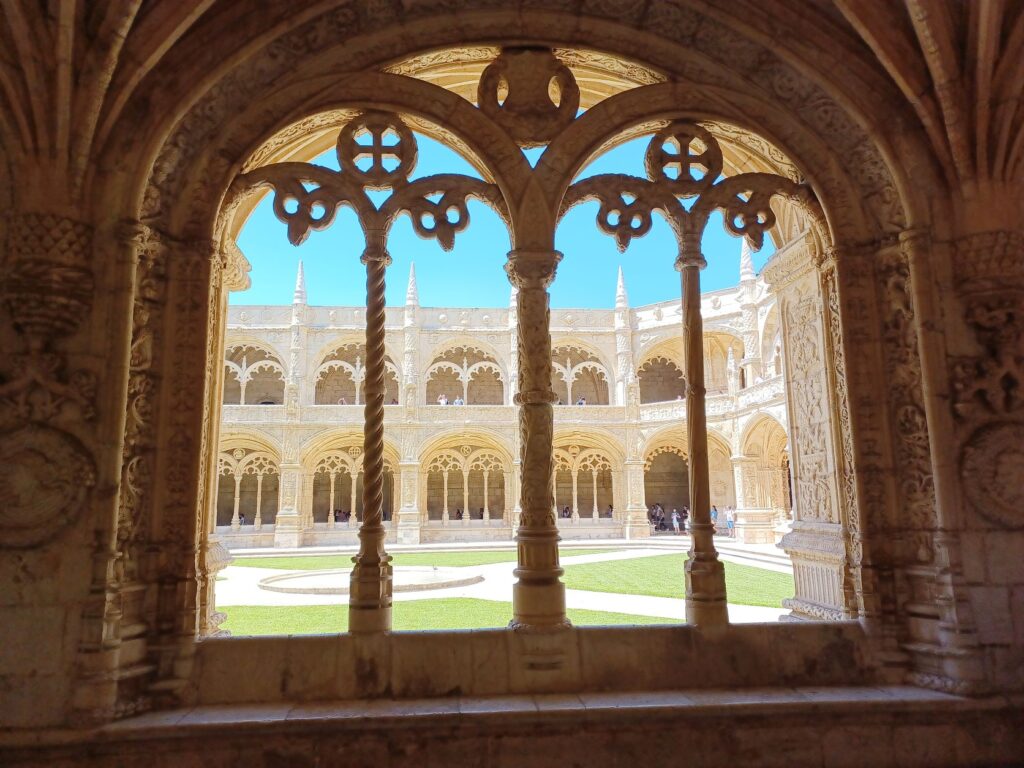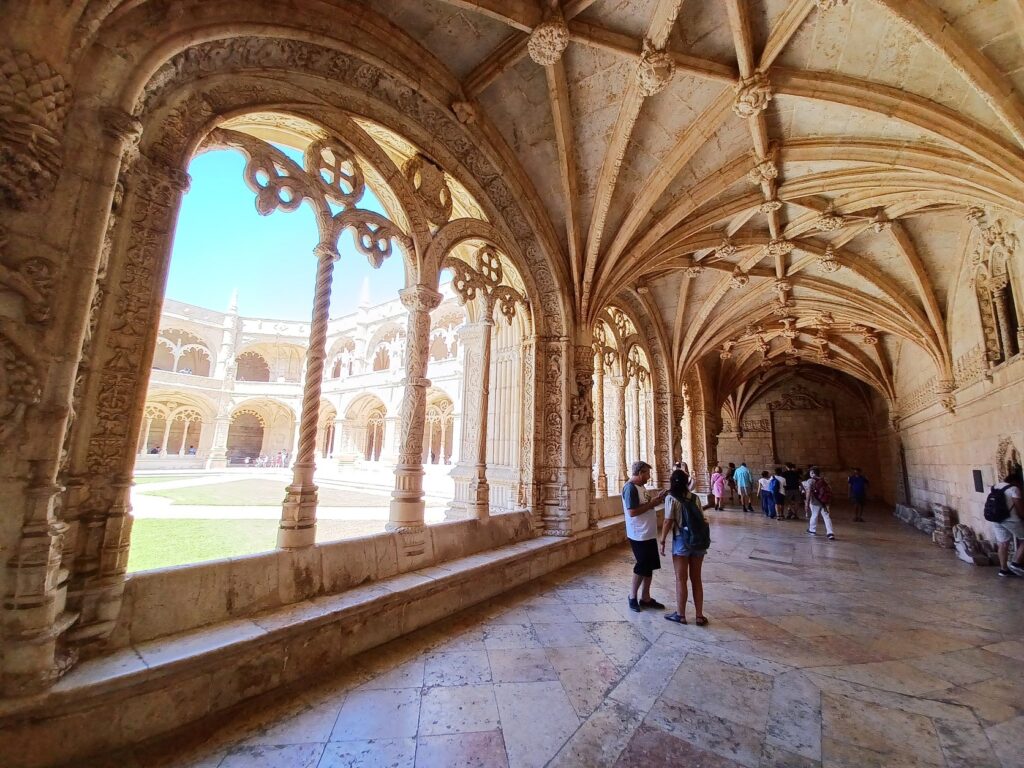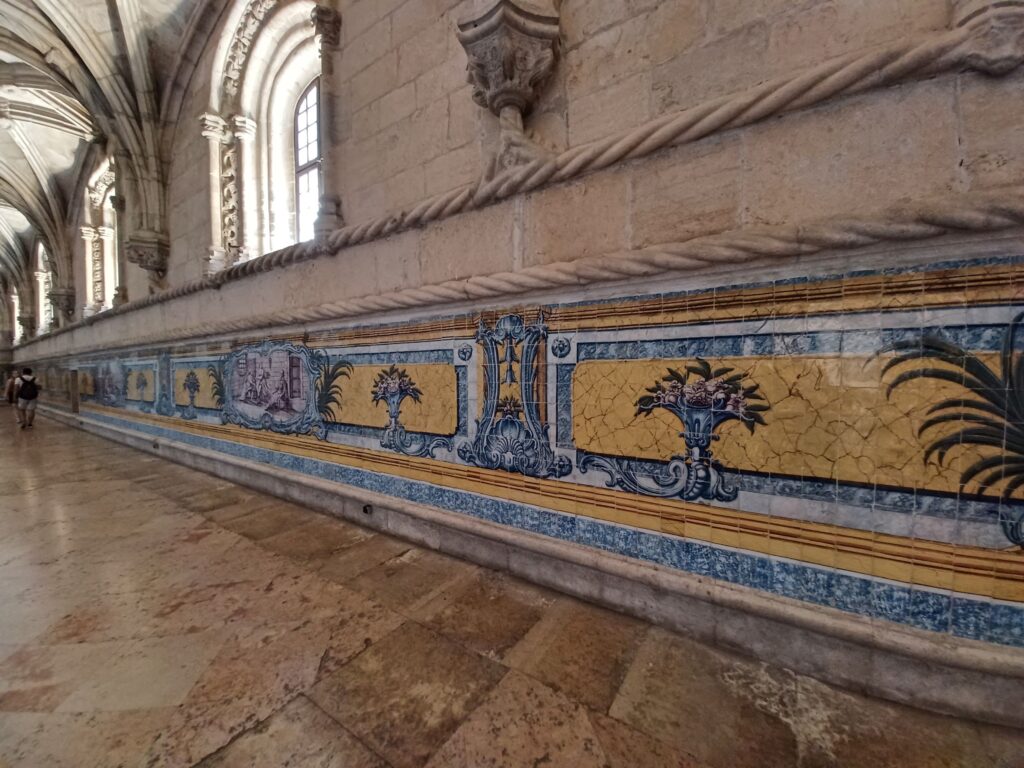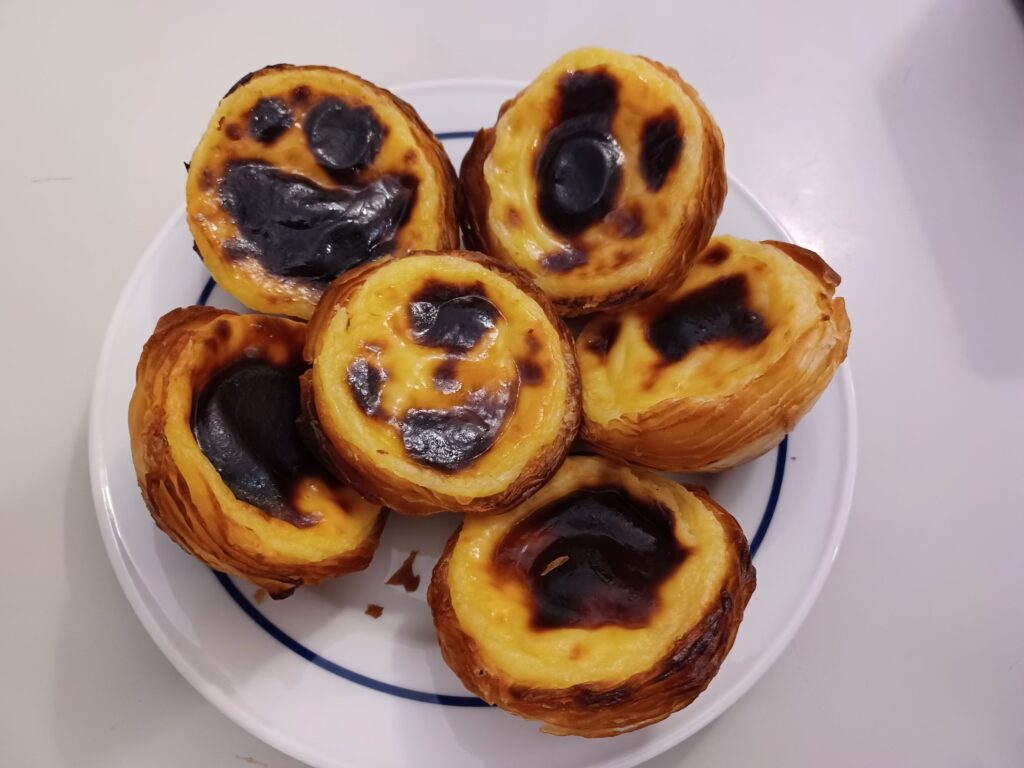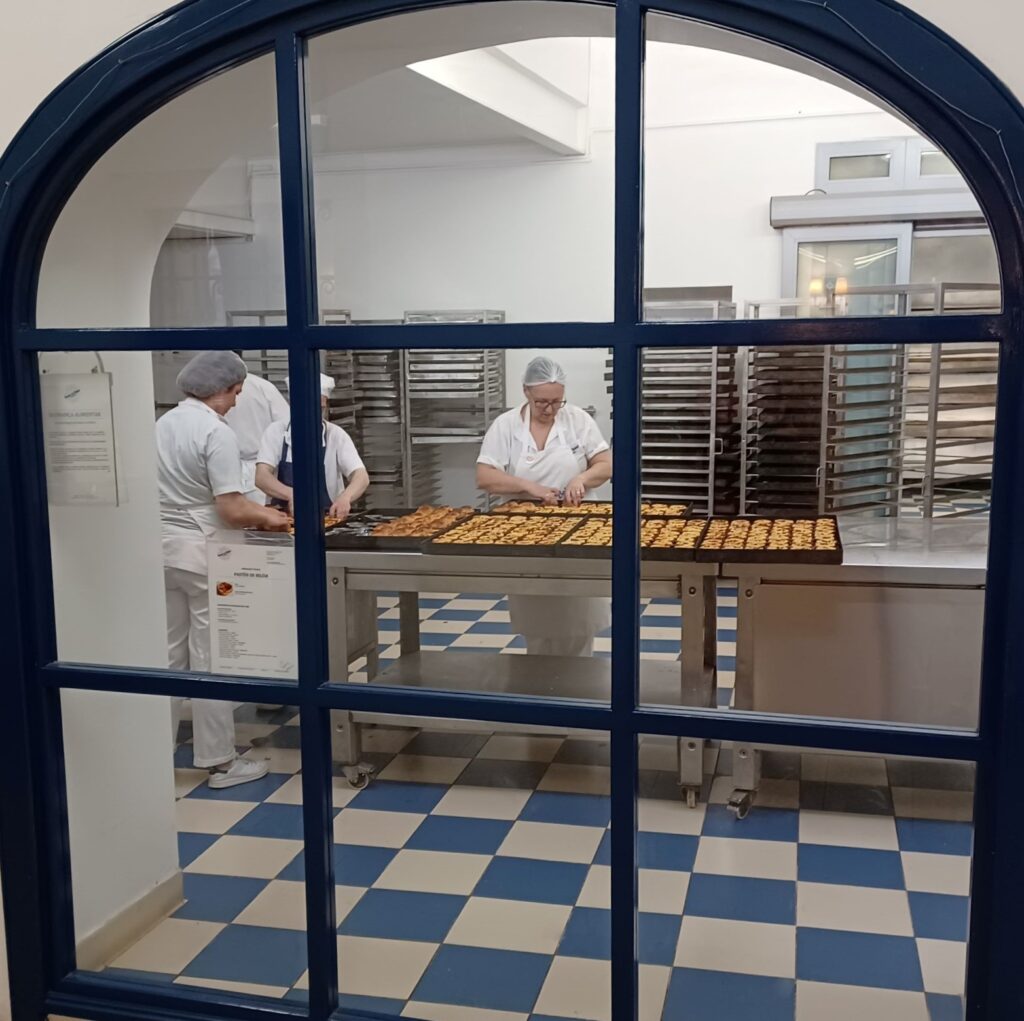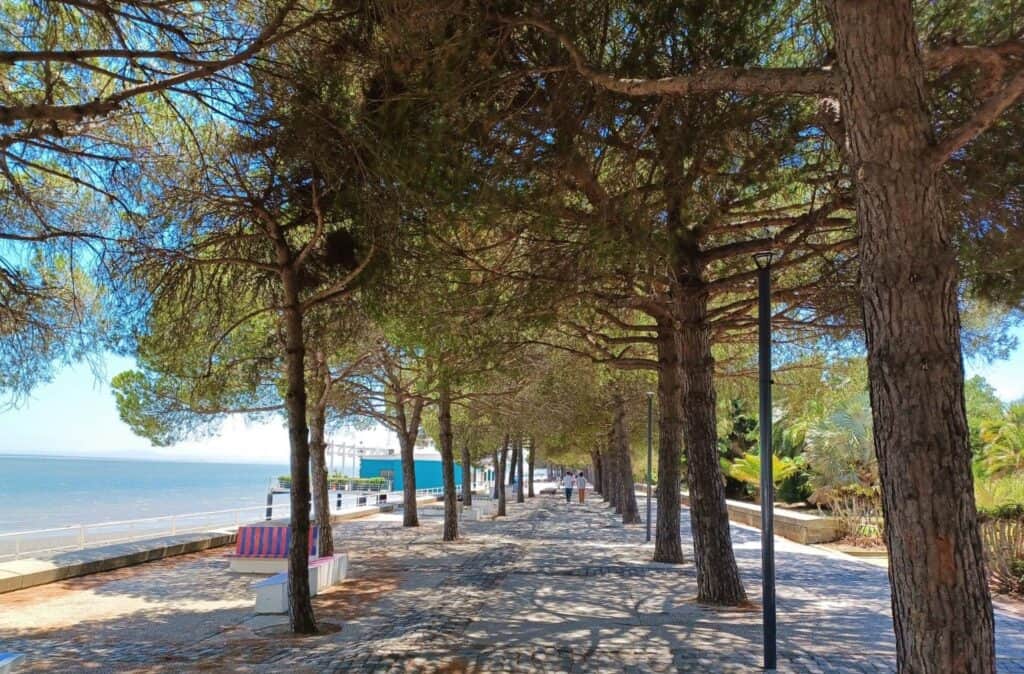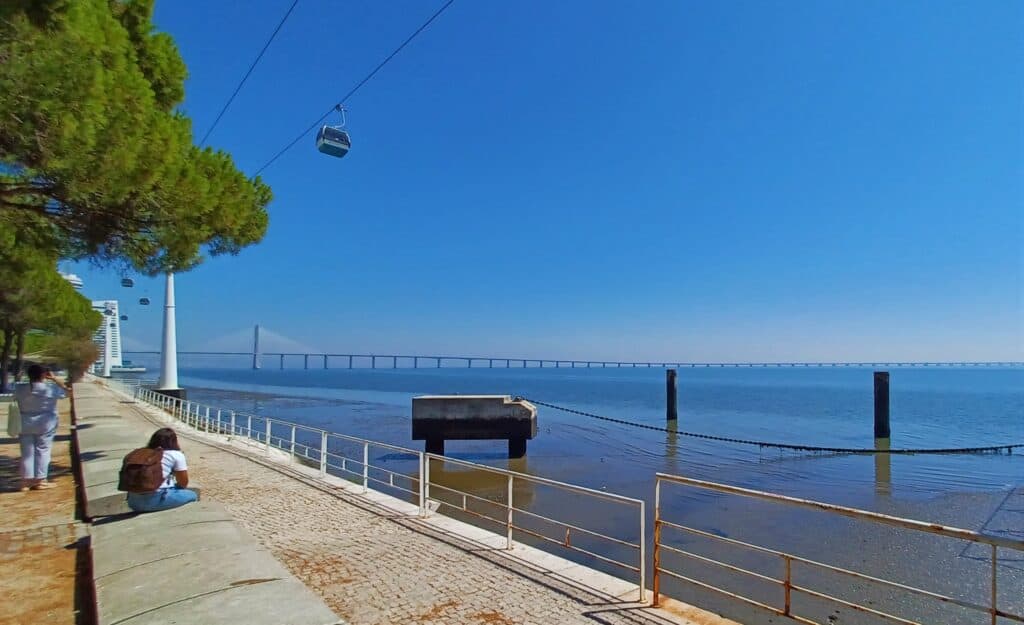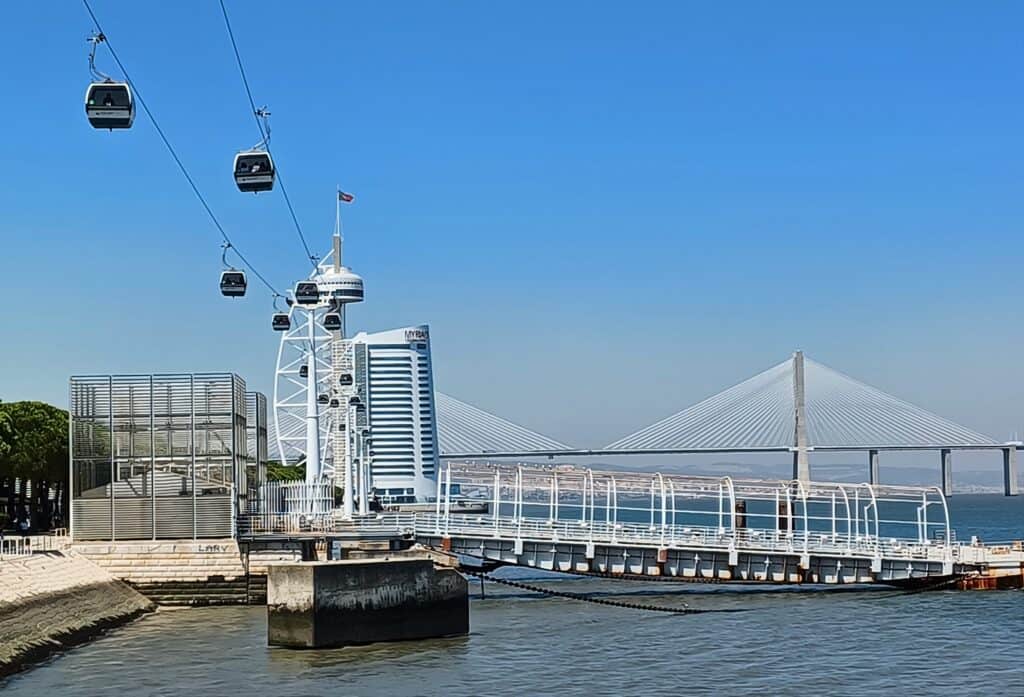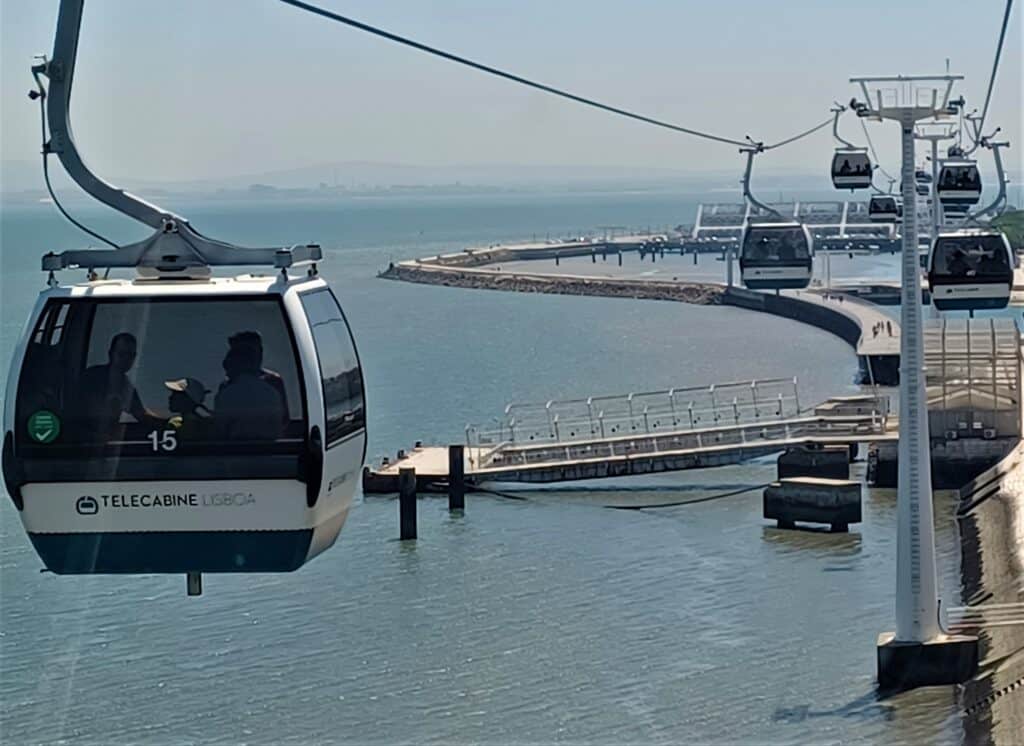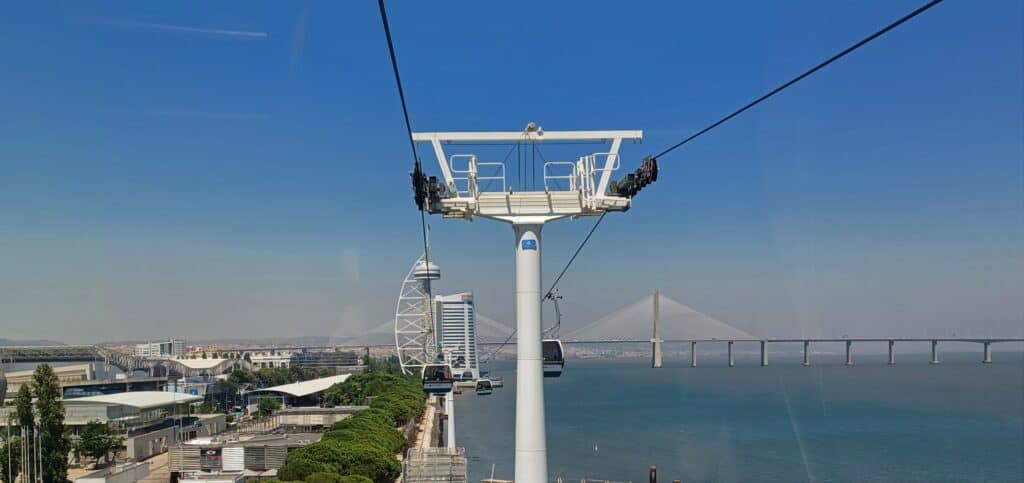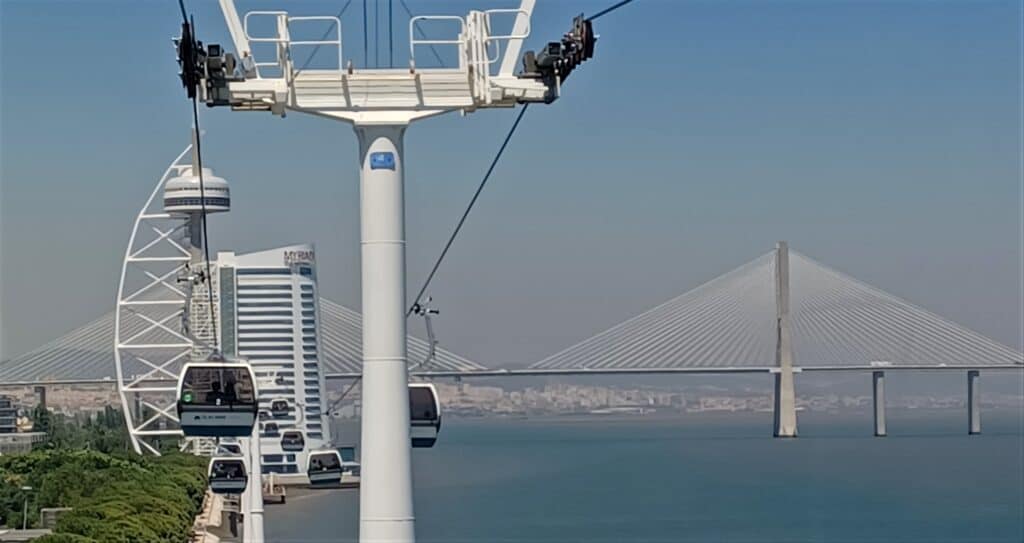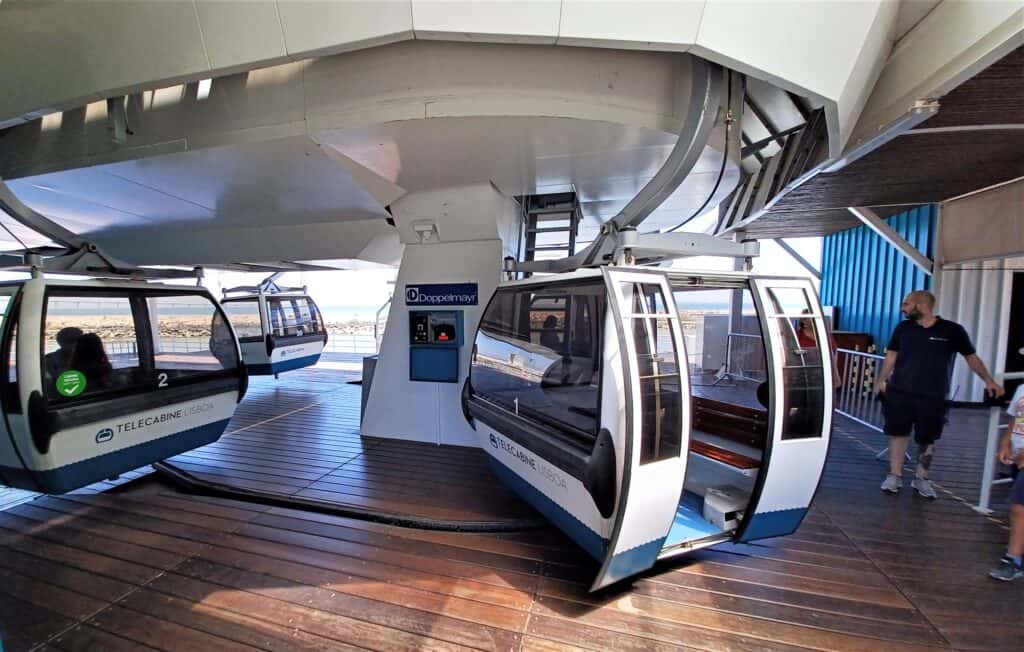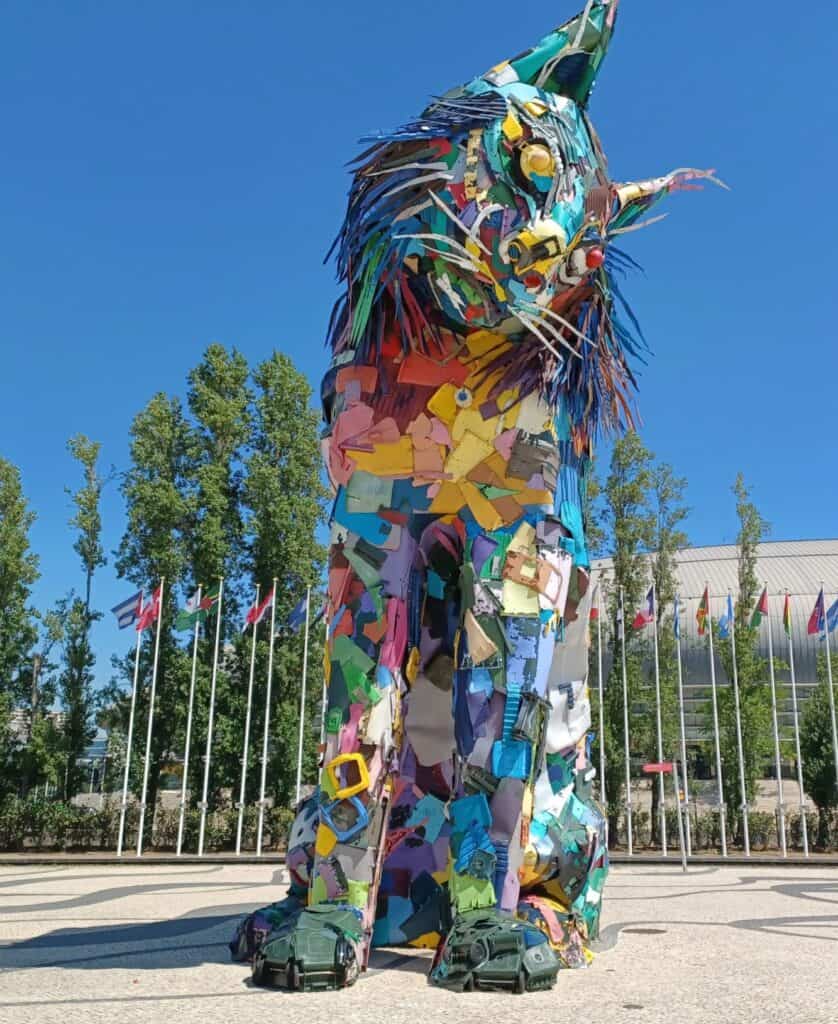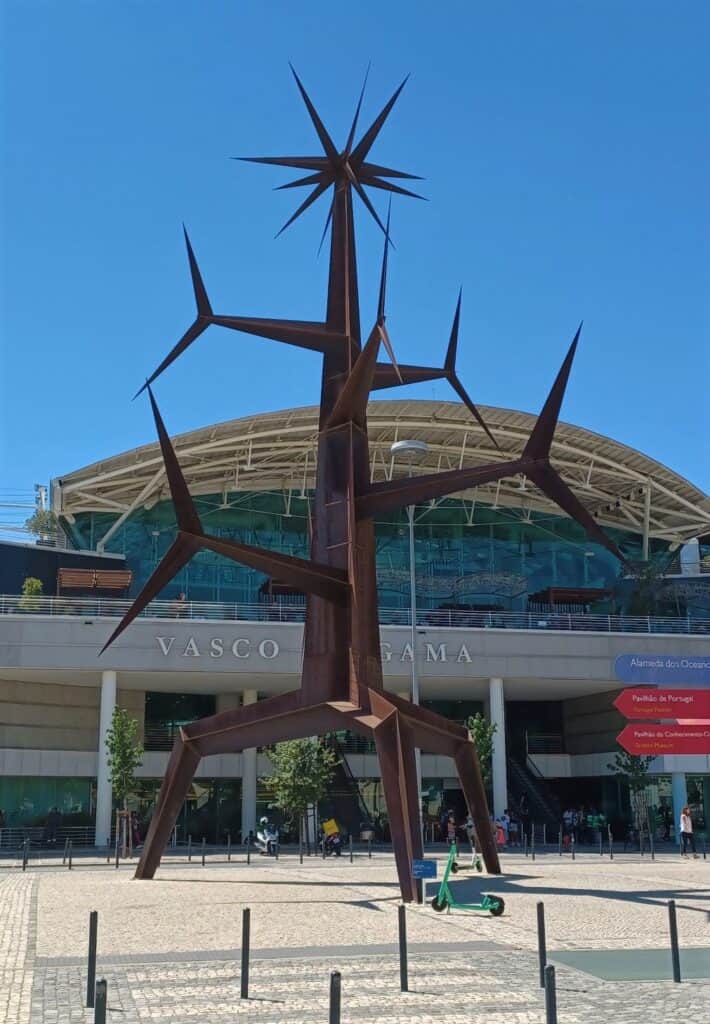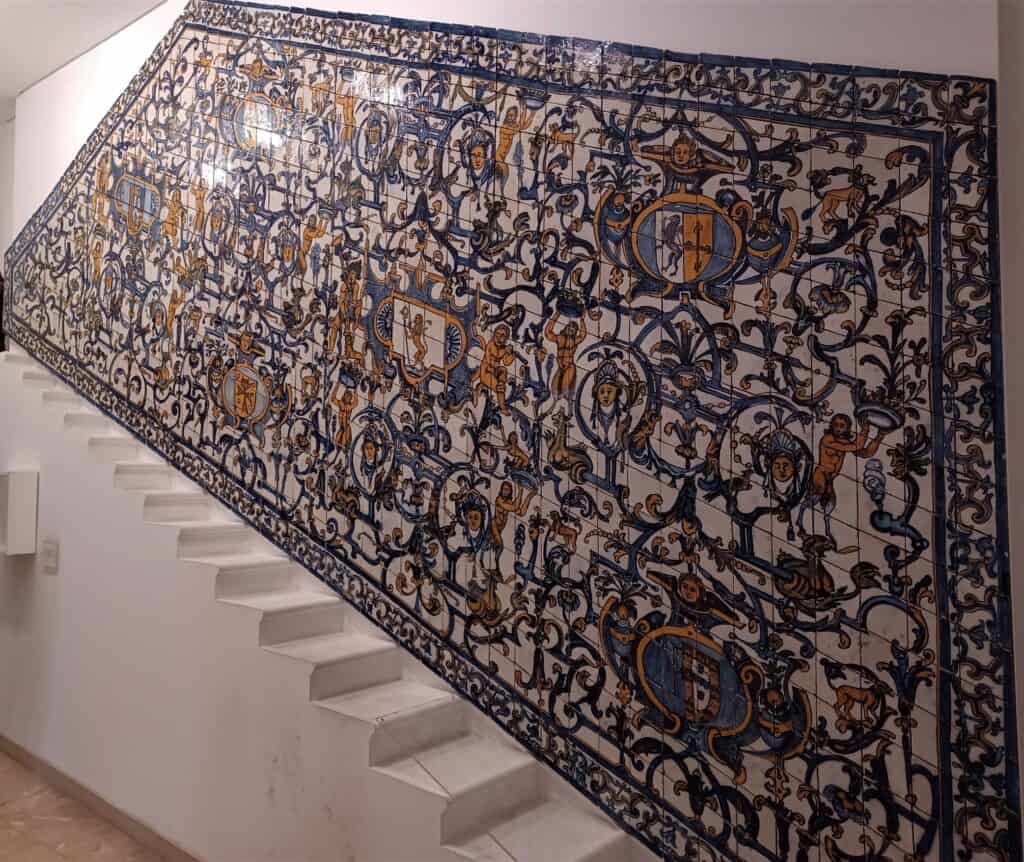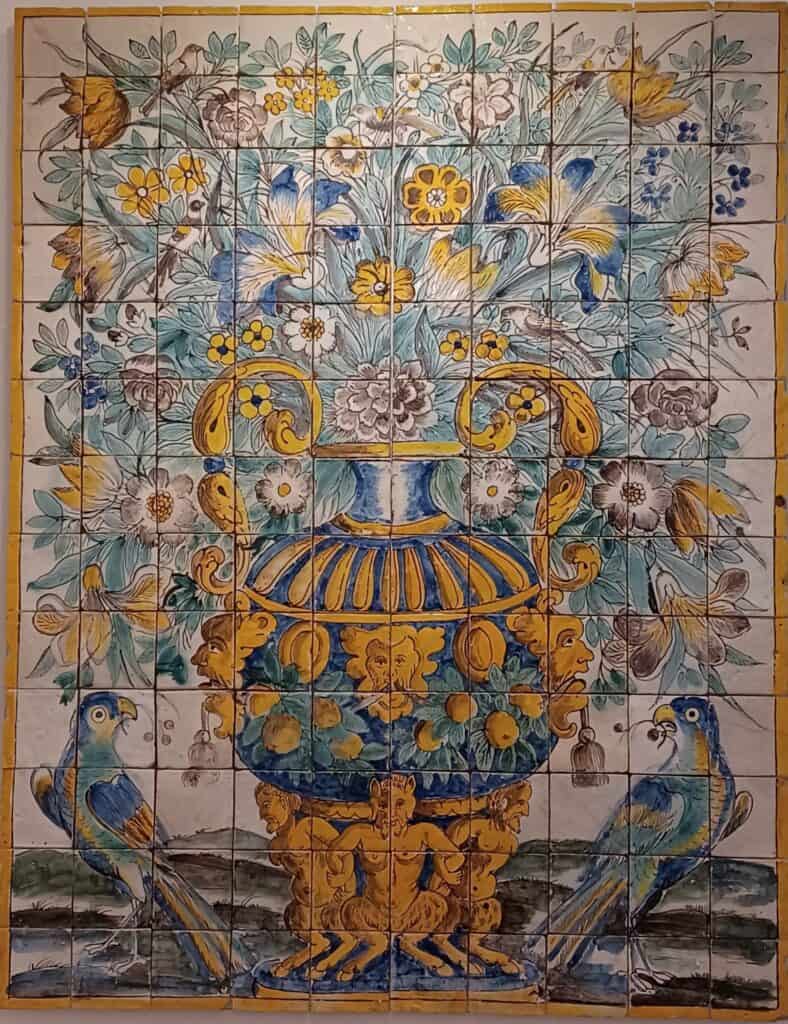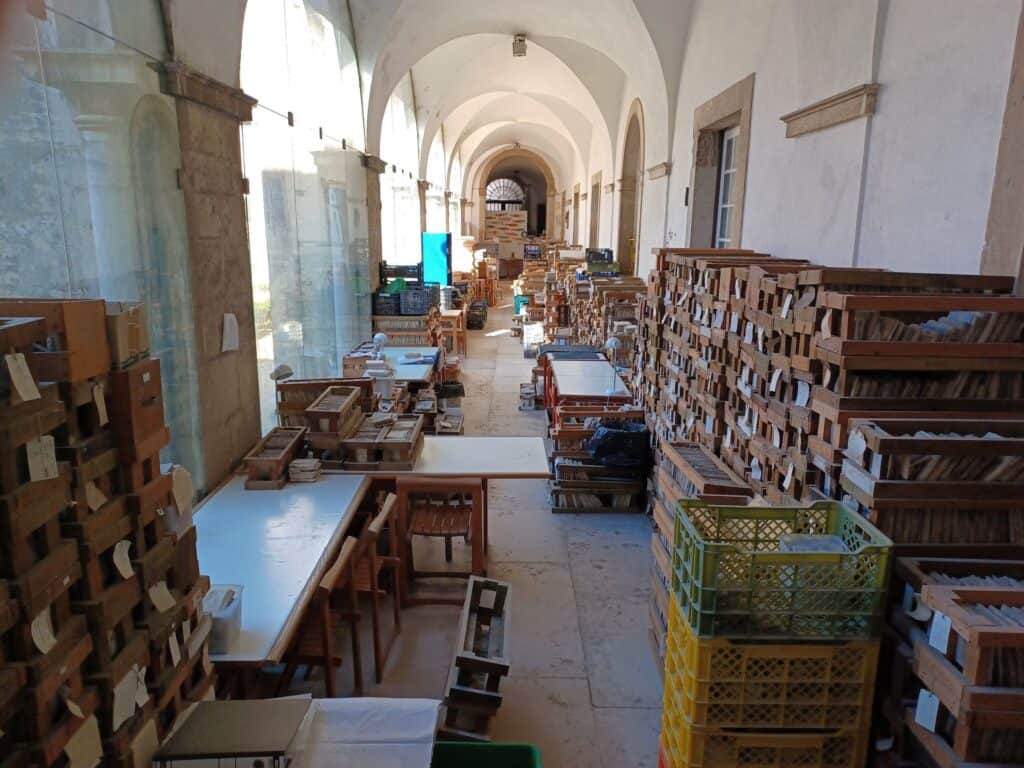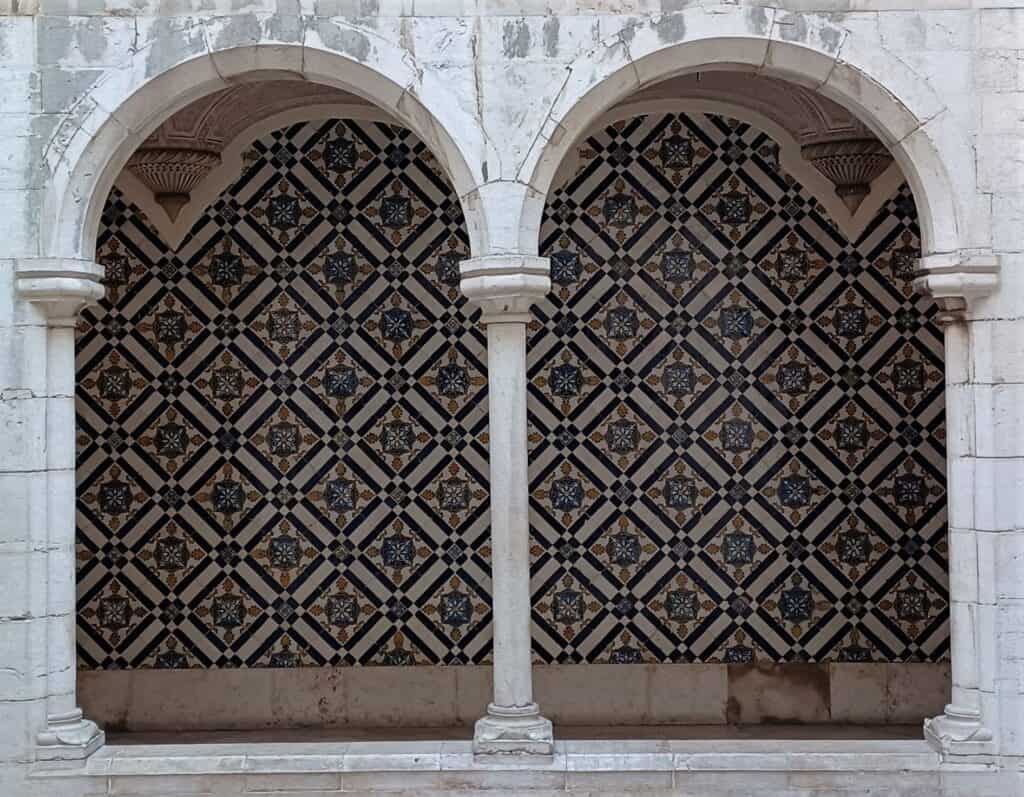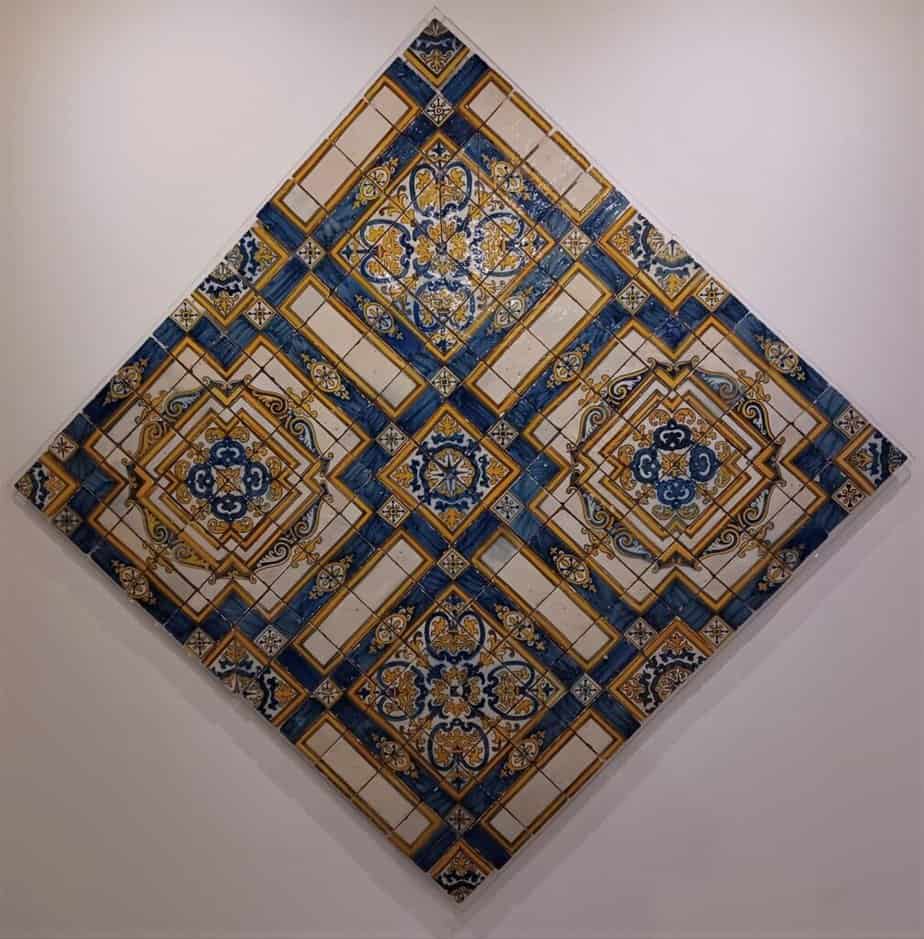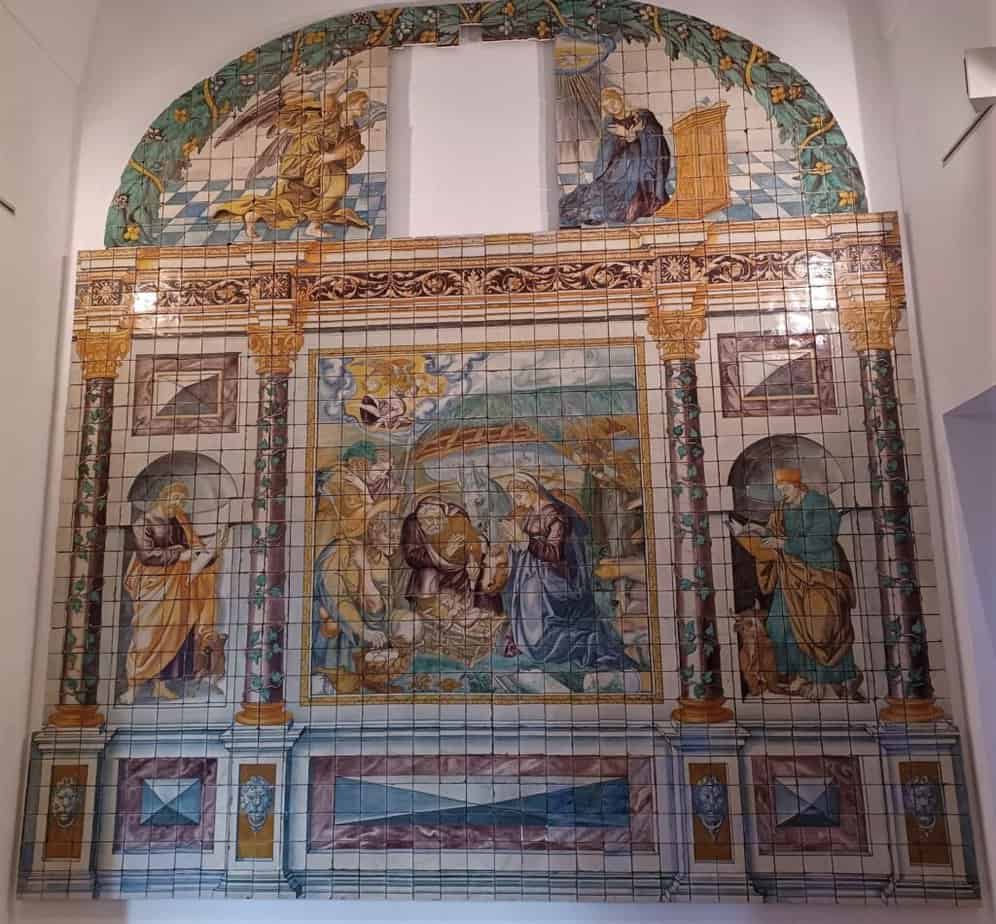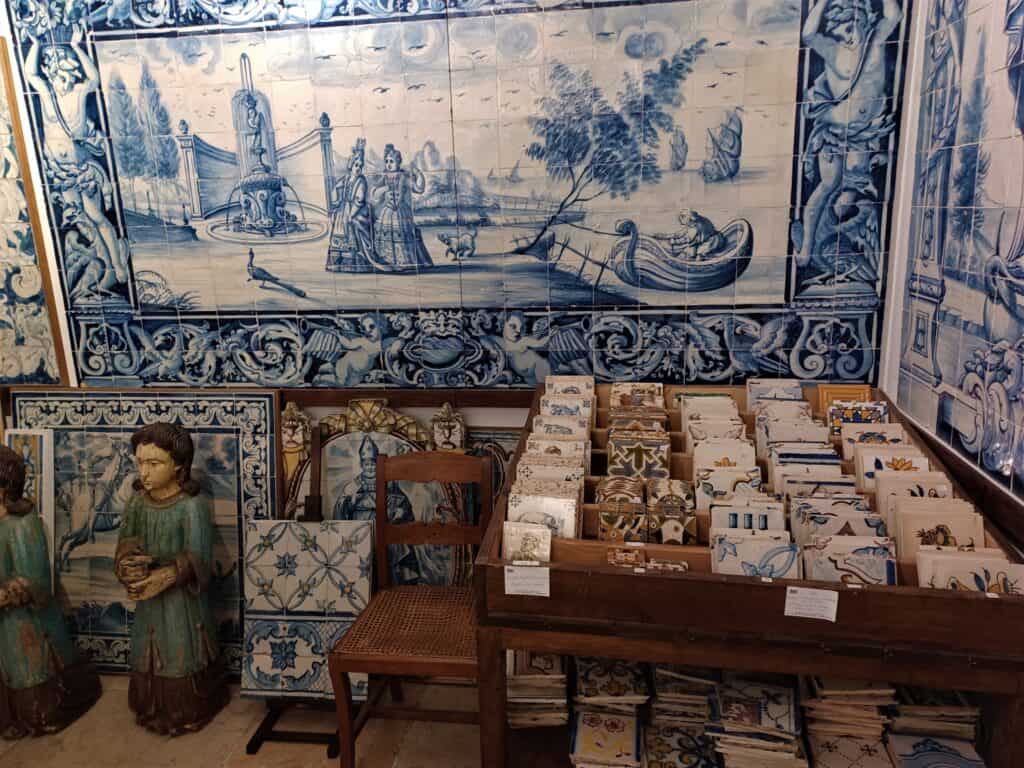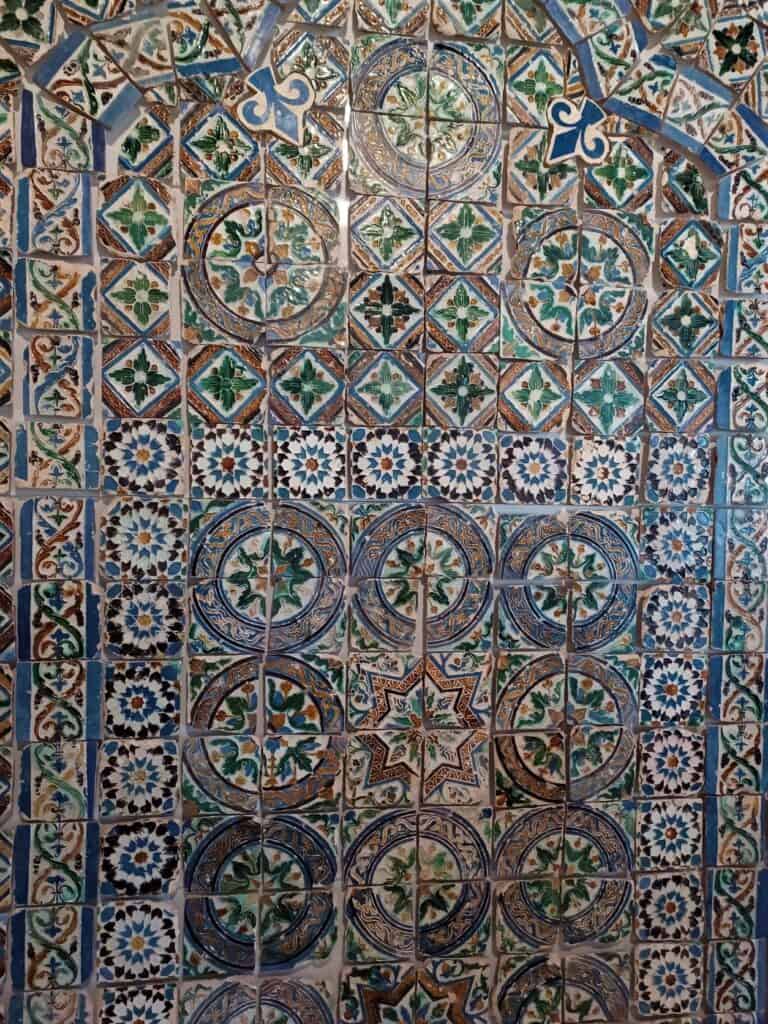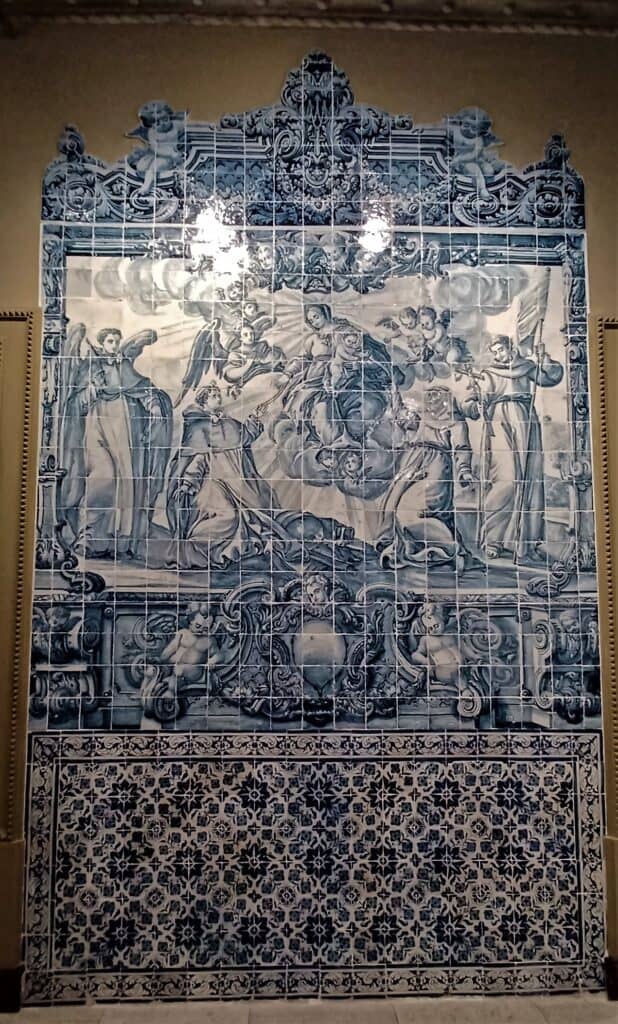Pastel de Nata, Ginjinha, and Charming Trams
Lisbon flew under the radar for a long time. But those days are over. Europeans are taking cheap flights to The City of Seven Hills for long weekends, and Instagram Tourists have discovered the city’s visual delights.
But, never fear, there’s still plenty of places that are less discovered and compared to the rest of Western Europe, Lisbon is still cheap; for now.
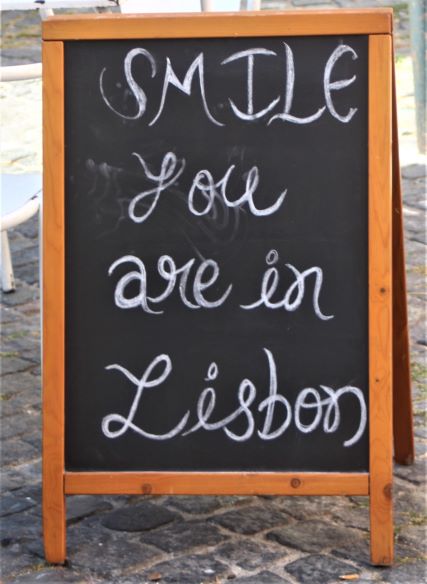
A Short History
Neanderthals occupied the area that is now Lisbon tens of thousands of years ago before dying out 30,000 years ago.
Ancient people called The Estrímnios lived here about 3,000 years ago when Lisbon was an outpost for trade with the Phoenecians. Rome took over in 205 BC and held much of the area until the fall of Rome when the Germanic Visogoths took over.
In 711AD, Moors from Northern Africa took over most of the Iberian Peninsula and held it for over 400 years. The Moors brought art, architecture, language, and food, remnants of which are still present in Portugal. In 1147. the Crusaders captured Lisbon after a four month siege.
The Age of Discoveries during the 15th and 16th centuries saw Portugal grow rich by colonizing Asia, South America, and Africa. Remnants of this past glory can be seen in places like the Jerónimos Monastery, but 85% of Lisbon was destroyed in 1755 by a massive earthquake, fire, and tsunami. Lisbon was rebuilt in the earthquake’s aftermath and many of the most beautiful areas of Baixa were constructed during this time.
The Republican Movement of the early 20th century saw the country trying to establish a democracy. King Carlos and his heir Luis Filipe were assassinated in Lisbon in 1908 and by 1910 the Portuguese Republic was established when the monarchy was overthrown. This led to a period of political anarchy and governments changed frequently until the fascist Estado Novo took over, led by dictator António de Oliveira Salazar.
Salazar ruled with an iron fist and did not tolerate dissent. He finally died in 1970, but the fascists held on until 1974 when the Carnation Revolution restored democracy. However, Salazar and his toadies had driven Portugal’s economy into the ground and the people were the poorest in Western Europe. Add to that an influx of refugees from newly independent colonies who needed jobs, and Portugal was suffering.
In 1986, Portugal joined the European Community and later, the EU which meant a huge influx of capital into the country to rebuild infrastructure and the economy. Today, the Portuguese still have the lowest per capital income in Western Europe and one of the lowest in the EU.
But, signs of a rebound are everywhere. Construction firms are engaged in projects all over the city and restaurants and cafes are filled with happy locals and tourists, spending money that goes further here than most of the rest of Europe.
Foodie Lisbon
Don’t be fooled into believing that eating in Lisbon is just a clone of Spanish cuisine. Portugal is unique as a great foodie destination in its own right and shouldn’t be overshadowed by its bigger neighbor.
Pastel de Nata
Pastel de Nata is by far the most popular pastry in Portugal. Monks at Jerónimos Monastery in the Belem section of Lisbon used egg whites to starch their habits and, as a result, had lots of egg yolks left over. Starting in the 18th century, the monks used the leftover egg yolks to make a creamy, custard-like pastry, the Pastel de Nata. When the monastery closed, the monks sold the recipe to a local sugar refinery. The owners of the refinery opened a bakery, Fábrica de Pastéis de Belém, in 1837. That bakery is still churning out delicious custard tarts to this day and is run by descendants of the first owners.

Living in Rhode Island for many years, I was familiar with Saint Anthony. Or should I say, I was familiar with the superstitions about Saint Anthony. Many friends (religious and non-religious) would pray to Saint Anthony if they lost something. Lose your keys? A chorus of “Pray to Saint Anthony!” would ring out.
Since Rhode Island has a huge population of Italian-Americans and everyone has a Cousin Anthony or an Uncle Tony, I assumed St. Anthony was an Italian saint.
Then, our friend Mariana took us to Pastelaria Santo Antonio for breakfast. Turns out Saint Anthony was originally born in Lisbon, went to school there, and studied at a monastery in Coimbra, Portugal. He later lived and work in both Italy and France, but he is the patron saint of Lisbon.
June 13th is St. Anthony’s feast day in Lisbon. On the day before (June 12th), outdoor stalls are crammed with potted basil plants, a traditional gift by men to their loved ones. Then, in the evening, there are parades and everyone indulges in sardines which are prepared on grills on every block. The 12th and 13th are both huge party days in Lisbon!
As far as the food at Pastelaria Santo Antonio, the Pastel de Nata’s have been voted the best in Lisbon (quite an accomplishment), and for good reason. They are light and creamy and if you get them right out of the oven, they are about the best thing on the planet.
Lisboetas will happily argue about who makes the best Pasteis de Nata. My vote goes to Pastelaria Santo Antonio, but there are plenty of devotees to Pasteis de Belem. Many guidebooks will steer you to Manteigaria, who also make a great Pastel de Nata. And, if you want a vegan version, Vegan Nata and daterra are excellent choices.
A couple other notes. First, a visit to Jerónimos Monastery (birthplace of the Pastel de Nata) is a must. Even though they don’t play up their relation to the invention of the iconic pastry, the ornate Gothic monastery has a jaw-dropping façade and an equally impressive interior. Explorer Vasco de Gama is entombed here.

Second, if you’re interested in St. Anthony, the Igreja de Santo António de Lisboa (Church of St. Anthony) isn’t far from Pastelaria Santo Antonio. The church was supposedly built on the site of Anthony’s childhood home. The church is where the St. Anthony Day parade starts on June 13th.
Finally, the story of excess egg yolks being used for baked goods and pastries isn’t unique to to Lisbon and Pasteis de Nata. I wrote about a convent in France that used the egg yolks that were a by-product of the winemaking industry to make little cakes.
Vegetarian Lisbon
No doubt about it, traditional Portuguese cuisine is heavy on the meat and fish. This can sometimes make it a bit challenging for vegetarians. But, more and more vegetarian restaurants have opened recently and Lisbon is becoming an outstanding city for veg/vegan dining. And, Portugal’s northern Duoro Valley supplies tons of fresh and tasty produce that makes vegetarian meals top-notch.
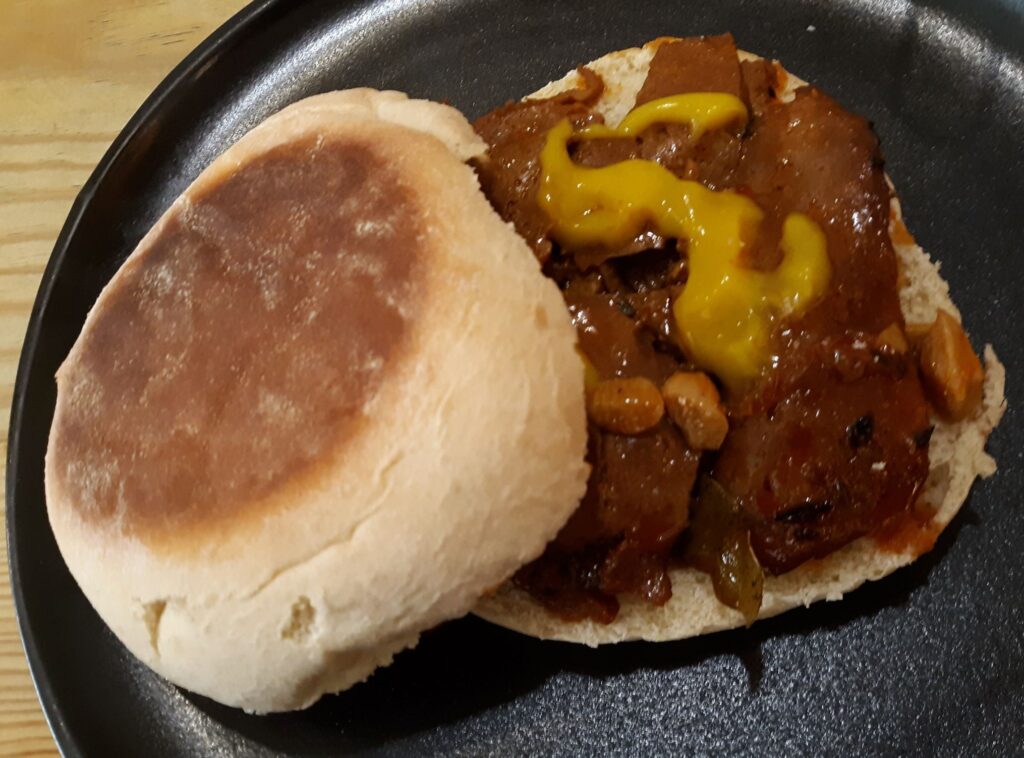
My number one spot for veggie dining is Ao 26 Vegan Food Project. Some of what they offer what might be thought of “typical” vegetarian fare, like quinoa salads with lots of veggies, but Ao’s menu is much more extensive than that.
Ao 26 has vegan versions of the famous Francesinha and Bifina sandwiches. They also have a terrific vegan version of Choco Frito, the specialty of nearby Setubal. This dish is made with breaded and fried cuttlefish. However, at Ao26, the vegan version is made with mushrooms and served with a delicious vegan aioli for dipping. Highly recommended.
The hippest spot for vegan dining in the city is The Food Temple. Located in the up and coming Mouraria neighborhood, this restaurant is a bit hard to find (especially if you’re relying on Google Maps). We were fortunate that some locals took pity on us when we were wandering around and pointed us down some stairs to the correct location.
Seating is limited, just a few tables inside and makeshift accommodations on the cement stairs outside. While not especially comfortable, I prefer the outdoor seating, especially on a nice Lisbon evening.
Oh, and the food is outstanding. The menu changes often, allowing for repeat visits without getting bored. Highly recommended.

I love visiting Buddhist restaurants when I visit a new city. The food is often very good, healthy, and the space is usually a tranquil respite from the choas just outside. Jardim dos Sentidos is that place in Lisbon. Their lunch buffet is filling and tasty even if the options jump all over the place (Indian, Thai, Italian et al). On Tuesday evenings Jardim dos Sentidos offers a three course meal with wine for just 36€. And, there is a lovely courtyard with tables shaded by trees to eat your meal and get some inner peace, if only for a few minutes.
Earlier, I mentioned daterra for their vegan Pasteis de Nata. But, they also do a nice job of making vegetarian versions of Portuguese dishes.
Markets
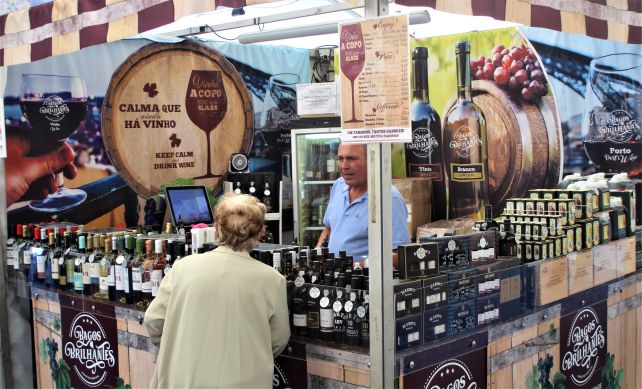
Portugal’s mild climate (and abundant rainfall in the north) makes for ideal growing conditions for many fruits and vegetables. This bounty is on display at Lisbon’s best markets.
My favorite is Mercado da Baixa, located, of course, in the Baixa district. While this area can be crowded with tourists visiting the Santa Justa Lift and Rossio Square, the Mercado da Baixa is packed with locals on their lunch hour from nearby office buildings.
Mercado da Baixa isn’t the fanciest food hall in Lisbon or the largest, but her charm lies in the vendors selling authentic prepared dishes, Ginjinha (see below), and fresh produce. The perfect spot to get provisions for a picnic.
The Mercado Biológico do Príncipe Real has a Sunday farmers market with organic produce that is another top choice.

Mercado da Ribeira (Time Out Market) is larger with more selections while Mercado de Campo de Ourique is smaller but is also an outstanding food hall. Lisboetas are definitely spoiled with choices when it comes to their markets.
Queijo de Azeitão
Portuguese cheeses don’t have the popularity of Spanish cheeses, but that doesn’t mean they are lacking.
One of my favorites is Queijo de Azeitão, a cheese made from raw sheep’s milk. As a Protected Designation of Origin product (PDO) Queijo de Azeitão can only be produced in the area around the town of Azeitão.
The cheese is soft on the inside with a slightly waxy, edible rind. If you smell Queijo de Azeitão you might be led to think that this is a mild cheese. But, woah, when you taste it! Barnyard floor! Just the kind of flavorful cheese that I love.
A unique thing about Queijo de Azeitão is that most producers don’t use rennet to make the cheese curds. Instead, many makers of Queijo de Azeitão use cardoon, a thistle, to bring the cheese together, making it vegetarian friendly.
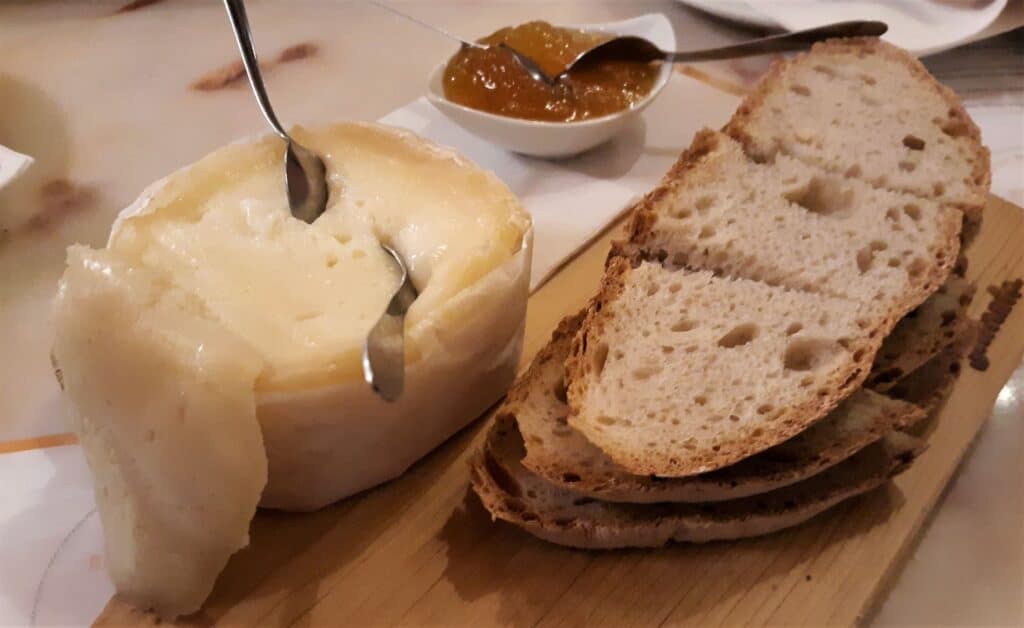
Practically any grocery store will carry Queijo de Azeitão and the Mercado da Ribeira (aka Time Out Market) or Mercado da Baixa to shop for some cheese, bread, olives, and wine for a picnic.
Transplanted Cuisine
During the so-called “Age of Discovery,” Portuguese navigators traveled the globe, looking for trade routes and establishing colonies for their country. Many of these colonies were in Africa, although Brazil was also a very important colony.
Today, people from former Portuguese colonies have emigrated to Portugal, and especially Lisbon, creating ex-pat communities of Brazilians, Cape Verdeans, Mozambicans, along with people from many other places.
Roda Viva is a tiny Mozambique restaurant hidden up an unassuming staircase in the Alfama neighborhood. Though not 100% vegetarian, Roda Viva has several veg friendly dishes.
Octavio Chamba owns the place (though he says he works “for the bank”) and does the cooking. His homemade piri piri sauce is terrific and he’ll even sell you a jar if you ask.
One of my favorites is Tchatinho. It’s listed as a Mutchutcho (snack) on the menu, but really, I find it plenty for lunch. Mushrooms and eggplant are cooked in a spiced tomato sauce. I don’t know what Octavio puts in the that sauce, but it’s divine.
Pair the Tchatinho with a side of Xima, a white corn dough that is quite similar to polenta. The Xima sucks up the delicious Tchatinho sauce and I can say is “wow.”
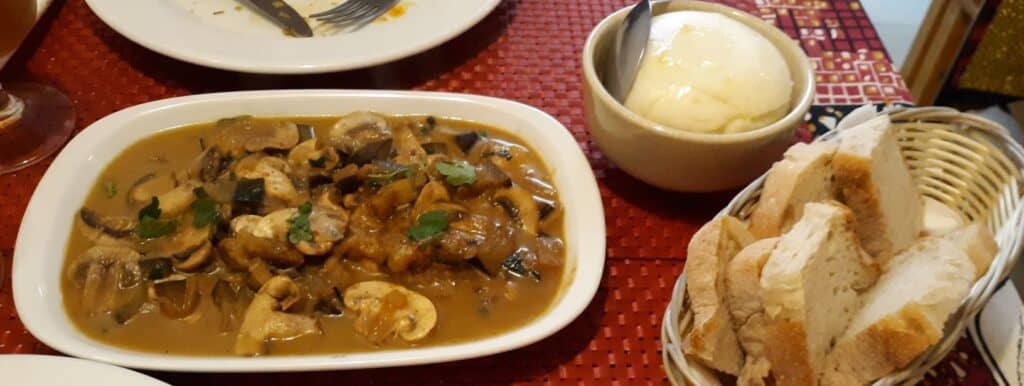
Tambarina is a Cape Verdean restaurant specializing in cachupa, a traditional CV stew of beans, sweet potato, and veggies. It’s usually served with fish or some other kind of meat(s), but Tambarina makes a vegetarian version as well.
Bacalhau à brás
Seafood is a huge part of the Alfacinha (person from Lisbon) diet. Octopus, sardines, and clams all make regular appearances on plates. But, Bacalhau (Cod) is by far the most popular dish.
It’s strange that Bacalhau became so popular in Portugal because the fish doesn’t swim in the waters nearby. But, the Portuguese were expert sailors and explorers and found cod plentiful in the cool waters near Newfoundland.
Bacalhau was salted and dried which allowed it to be preserved for months at a time, perfect for long sea voyages.
Today, they say there is 365 recipes for Bacalhau, one for each day of the year. The most popular in Lisbon is Bacalhau à brás.
To prepare the dish, the salted cod is soaked overnight and shredded. Shredded potatoes and onions are fried and an egg is added to the cod, potato, onion mixture. Olives are often added as a garnish.
Finding a vegan version of Bacalhau à brás isn’t always easy, but Ao26 sometimes has it on the menu.
Drinking in Lisbon

There is a wide range of options when looking for a beverage in Lisbon. Excellent and little-known (to U.S. visitors) wines are everywhere. And, Lisboetas are spoiled with options when it comes to coffee and cafes to enjoy a cuppa. But, a tiny cup of Ginjinha from a closet-sized bar is some of the most fun you can have in Lisbon.
Ginjinha

Having a Ginjinha is one of the highlights of a trip to Lisbon. Served in little plastic shot glasses and usually costing about 1.5€, getting a Ginjinha is cheap way to have some fun.
Ginjinha is made by adding cinnamon, sugar, and, sour cherries to brandy. The drink was invented by a friar at the Church of St. Anthony in Lisbon who added sour cherries to brandy. He shared the recipe with a Galecian man named Espinheira who perfected the recipe by adding sugar and cinnamon.
Espinheira opened the Ginjinha Espinheira bar in 1840 and today the place, now known as A Ginjinha, is still in business.
Don’t expect to come in and sit down for a drink at A Ginjinha. The bar is nothing more than a counter that opens to the square with bartenders pouring shots of the sweet drink into tiny plastic cups. Get yours with or without a cherry in the glass and stand outside with the locals and tourists enjoying the sweet elixir.
A couple minutes walk away, also in Baixa, is another characteristic Ginjinha bar. This one is called Ginjinha Sem Rival. They’ve been in business since 1890. Give both A Ginjinha and Ginjinha Sem Rival a try. Everyone has a favorite.
If you talk to Lisboetas who are middle-aged or older, they will likely tell you about how their parents and grandparents would give them a little shot of Ginjinha to cure everything from the common cold to a sore throat.
Wine
The second largest winemakeing region in Portugal is around Lisbon (the first is the Duoro Valley). Many of the vineyards in the Lisboa wine region (until recently known as Estremadura) are small farms that sell their grapes to co-ops for Portuguese table wines. But there are also some regions that make fine wine as well.

When looking to buy a bottle, look for the DOC classification (Denominação de Origem Controlada) on the bottle. This indicates that the wines have been tested and tasted and the grapes have been grown in a certain geographic region that is particularly good for winemaking.
Indicação de Proveniência Regulamentada (IPR) is just under DOC in prestige.
The next classification is Vinho Regional (sometimes listed as IG or IGP on the bottles). These wines are produced under less strict regulations and often contain lesser-known regional grape varietals.
The last classification is Vinhos de Mesa. These bottles are table wines.
Within Lisboa, there are several regions with the DOC designation.
Because Lisbon’s suburbs are expanding outwards, many vineyards have been plowed under to make room for expensive housing in the countryside. But, some areas, like Bucelas have expanded grape production.
Bucelas is known for its white wines, especially those made with Arinto grapes and blended with Esgana Cão. These nice acidic whites often have notes of citrus and won’t bust your budget.
For red wine, look for bottles from the Arruda and Alenquer DOC in Lisboa.
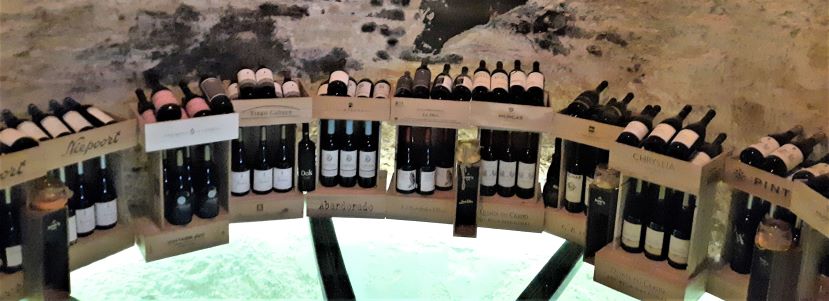
Carcavelos DOC is known for their fortified wines, although these are becoming harder and harder to find with real estate development swallowing up many former vineyards.
The vineyards of Colares DOC are planted in a sand. And, since phylloxera aphids cannot live on sand, these are rare European vines, some of the few that were not devastated by phylloxera and replanted with New World rootstock. But, what phylloxera couldn’t kill, sprawl has. 98% of the vines under cultivation have been removed for suburban construction.
Lisbon Winery
One of my favorite places to do a wine tasting is at Lisbon Winery in Bairro Alto.
The owner of Lisbon Winery, Adriana, is super knowledgeable about Portuguese wines and is happy to answer all your questions. They also have a great selection of cheeses to pair with your vinho selection.
I noticed a bottle displayed on the shelf in which there was a perfect cut across the neck of the bottle. Asking our server she explained that the tradition was to open a bottle of vintage Port by heating the neck and using a pair of tongs to open it rather than by removing the cork.
I asked her if they had a pair of tongs at the winery and she came back a few moments later holding the large tool. Super cool, but I think a corkscrew would be much more convenient.
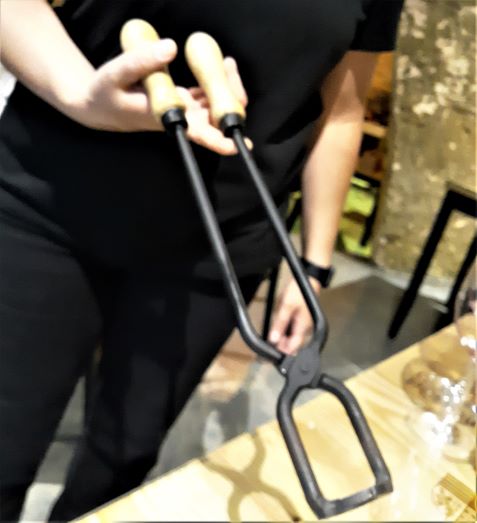
Coffee
When have a Pastel de Nata, there’s no better compliment than an espresso, or as it’s known in Lisbon, uma bica.
Coffee has been popular in Portugal for centuries ever since the imperial Portuguese brought coffee plants to colonies like Angola, Cape Verde, and, especially, Brazil. Today, Portuguese-speaking Brazil is far and away the largest exporter of coffee beans in the world.
You can get a an excellent uma bica at many Lisbon bakeries like Pastelaria Santo Antonio, but a highlight of a trip to Lisbon is a stop at Café A Brasileira.

In the early 1900’s coffee was not especially popular in Portugal. In 1905, Adriano Telles aimed to change that by importing and selling Brazilian coffee at his shop called A Brasileira. Customers who bought a bag were treated to a free cup, uma bica. Shortly thereafter, a cafe was added which became a meeting place for the intellectuals, poets, and revolutionaries who were working to move Portugal from a monarchy to a modern government.
One of the most famous of these was Portuguese poet and writer Fernando Pessoa. He authored Mensagem (Message) along with hundreds of other works. A frequent customer of A Brasileira, he now permanently sits outside the cafe in the form of a bronze statue.
Inside, the art deco cafe is now mostly filled with tourists and students, but the striking atmosphere is still a great place for uma bica.
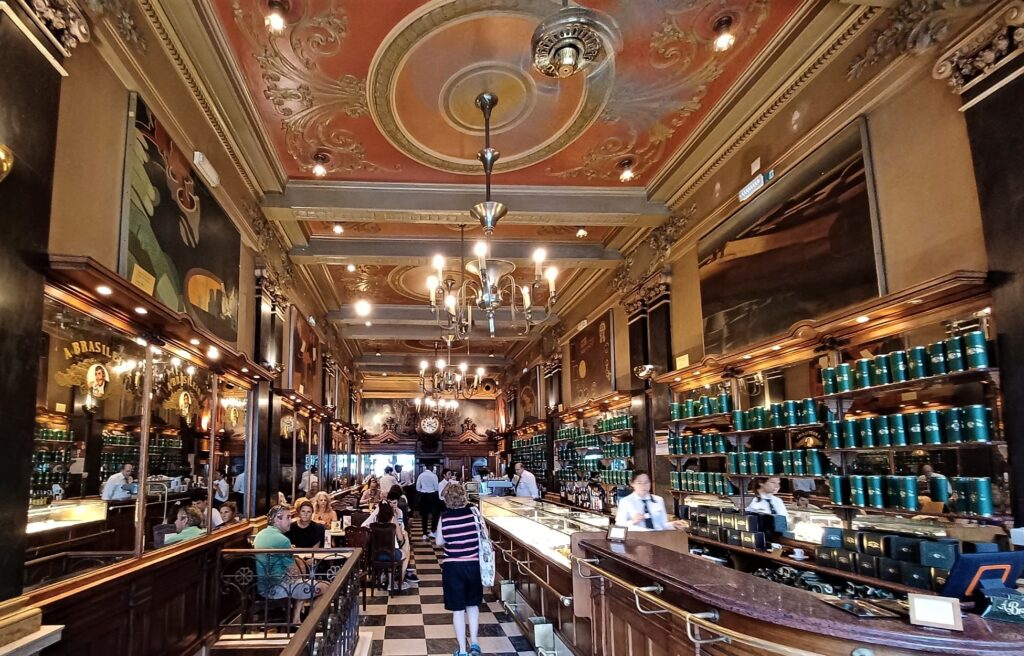
Amendoa
Portugal is a big almond producing country and the northeast region of Trás-os-Montes is where the majority of the country’s almonds are grown. Sweeter varieties of almonds are sold for snacking, but the region also grows a famous bitter almond. These are not popular for eating raw or roasted so many of the bitter almonds grown here are distilled into a liqueur called Amendoa.
Amendoa has a golden color and slightly sweet taste of vanilla and nuts. With 20% ABV, Amendoa isn’t meant to be chugged, instead a small glass is often offered as a digestiv. Sometimes you’ll see Amendoa used as a topping for ice cream.
If you’ve ever had Amaretto from Italy, you’ve tasted a similar drink. However, today, most commercial Amaretto is made from peach pits rather than the traditional bitter almonds. Besides, there’s nothing like sitting in a cafe in Lisbon while sipping an Amendoa and watching the trams and people go by.
Things to do in Lisbon
Earthquake
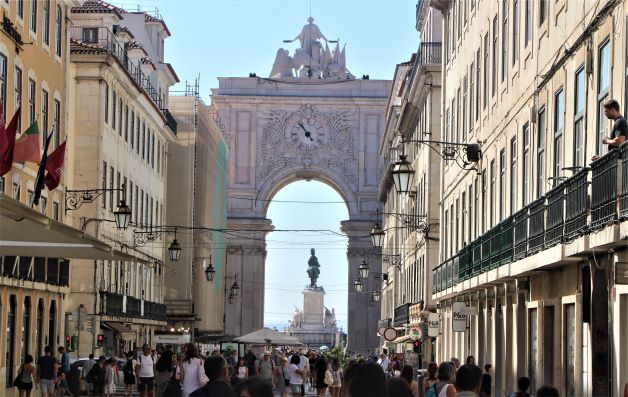
On the morning of Saturday, November 1st, 1755, most of the citizens of Lisbon were in church. It was All Saints Day, after all. At 9:40 am catastrophe struck. An earthquake measuring 9.0 on the Richter Scale (the strongest earthquake ever in Europe) shook the city for five minutes, opening 16 foot wide crevices and starting a massive fire. Then, a tsunami crashed into the city, killing more people.
When the shaking stopped and the fire was put out, Lisbon lay in ruins and up to 100,000 were dead. Parts of the city survived, namely Belem, but for Lisboates, a long rebuilding project lay ahead. And, because of this focus, Portugal’s imperial ambitions to expand its empire were put to rest.
One of the best examples of the rebuilding of Lisbon in the earthquake’s aftermath is Praça do Comércio (Commerce Square). See below for more about how Praça do Comércio was rebuilt without help from the king.
The Portuguese people did a lot of collective soul-searching after the quake as well. Some wondered if the devastation was some kind of divine retribution for Portugal’s sins of empire building and enslavement.
Voltaire, the French author, wrote “Poem on the Disaster in Lisbon” in 1756. In it, he disagrees with the “sins of Portugal” explanation for the natural disaster.
“What crime, what sin, had those young hearts conceived That lie, bleeding and torn, on mother’s breast? Did fallen Lisbon deeper drink of vice Than London, Paris, or sunlit Madrid?”
Carmo Convent
One of the only tangible remnants of the quake is the Carmo Convent. Built in the late 14th and early 15th century, the Gothic church had over 100 clerics housed on the grounds and an extensive library with over 5,000 volumes at the time of the 1755 earthquake.
The seism destroyed the library and severely damaged the church, causing the Order to abandon it. The site remained unrestored and uninhabited until it became the Museu Arqueológico do Carmo (Carmo Archaeological Museum). The small museum inside is interesting, but the real attraction is the church, whose roof was never rebuilt and ruins stand as a reminder of that terrible morning in 1755.
Trams
Lisbon is often compared to San Francisco. Both cities have hilly terrain, have suffered devastating earthquakes, are known for their iconic bridges, and both have charming cable cars that people love to ride. Except, in Lisbon, they’re called trams.
The tram system first began operation with horse drawn cars in 1873. The lines were electrified in 1901 and 1902 and coverage was expanded to over time to a peak of 24 routes in the 1950s. Lisbon’s bus and metro system diminished the importance of the trams and the system has shrunk over time to the current six tram lines.
The trams are popular with both locals and tourists. Tram line 28 is one of the best for tourists as it runs through the picturesque Alfama district. But, this tram is also the most crowded and pickpockets target tourists. If you ride the 28, zip up your valuables and keep your bag or purse close to your chest. Cameras have been known to be stolen by thieves cutting the strap with a knife.

Tram line 15 is also popular because its line takes passengers out to the Belem section which is relatively far from the center of town. This tram is modern and lacks the charm of the older carriages, but if you’re going to Belem, and you should, it will get the job done. Pickpockets also frequent this line.
Tickets can be purchased on board. One ride is 3€, but a 24 hour pass, covering trams, buses, metro, funicular, and even the Santa Justa Lift is only 6.40€. The passes must be purchased at a metro station.
Fado
Fado is the soul or folk music of Lisbon. A singer is accompanied by a 12 string guitar player or two and, perhaps, a couple other string instruments like an 8 string bass. The 12 string guitar adds to the melancholy of the singing. Modern Fado can also have percussion, piano, and other instruments.
Fado translates to fate or destiny but also means “a longing.” Fado has been compared to American Blues music because of depressing subject matter in both genres, although musically, they have little in common. To give you an idea, Portuguese writer Manuel de Mello called Fado ‘a pleasure you suffer, an ailment you enjoy’. Sounds like a description of the Blues, right?

Fado originated in Lisbon in the first half of the 1800s and was often sung in bars frequented by the people residing on the lower rungs of society like sailors and prostitutes. The first star of Fado was Maria Severa Onofriana (aka A Severa), a singer and guitarist, who was also a prostitute. She died of tuberculosis in 1846 at just 26 years of age. The legend of A Severa grew through novels, plays, and films about her life. The site of Maria’s house was a Fado House called Maria da Mouraria.
If you want to see Fado performed live, you can go to a Fado House. These places often provide an intimate experience, but you likely will need to purchase dinner to see the show. Or, wander a neighborhood like Bairro Alto and look for signs outside bars advertising a Fado show. This is usually a less expensive way to see Fado, though many of the best singers perform at Fado Houses.
There is also an excellent Fado Museum in Lisbon. The good folks at the museum often schedule Fado performances at the museum and other locales around the city. Check their website for dates/times.
And, if you’d like to get a grounding in Fado before your trip, listen to some. The Rough Guide To Fado Legends is a good place to start.
Bairro Alto
Bairro Alto is one of the most famous neighborhoods in Lisbon, and for good reason. This is where locals and tourists come to party. Filled with bars and restaurants, there’s something for every taste, especially if that involves staying out late.
The Seven Hills of Lisbon is a real thing. And while the terrain makes for lovely vistas and charming winding streets, all the climbing gets old real fast. That’s why you have to be smart about getting to Bairro Alto (Alto is High in Portuguese, after all).
Elevators and Funiculars
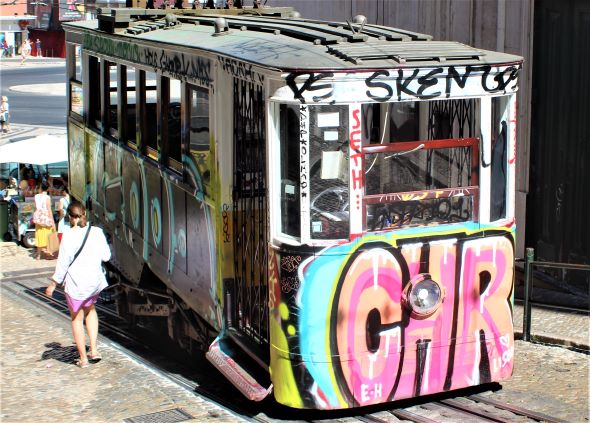
Taking a taxi or tuk tuk (an expensive ride in a glorified golf cart) is one way to avoid the steep climb to Bairro Alto. But, smart tourists do like the locals and jump on a funicular.
Elevador da Gloria’s little street car runs from Restauradores Square to Bairro Alto in a couple short Instagram-worthy minutes. The cost of a single ticket is a little steep (see what I did there?) at 2.90€, but getting the Viva Viagem Card saves 50%. Holders of the Lisboa Card ride for free. There’s also the Bica Funicular and Elevador do Lavra.
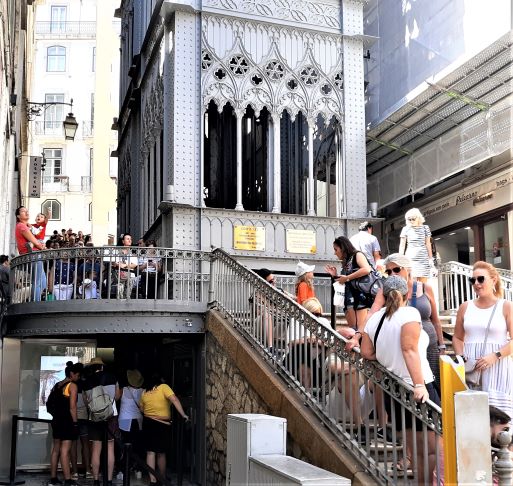
The Santa Justa Lift (aka Carmo Lift) is an actual elevator connecting Baixa with Carmo Square. Because of it’s beauty, Santa Justa has become a huge tourist attraction. It is incredibly crowded at all times of day and night with people waiting in line for hours to get a ride.
In my opinion, the ride isn’t worth the wait. Instead, take the Elevador da Gloria funicular and take the short walk through the picturesque streets of Bairro Alto to the top of the Santa Justa Lift. Here, you can access the view without waiting in the ridiculous line below.
The Old Pharmacy
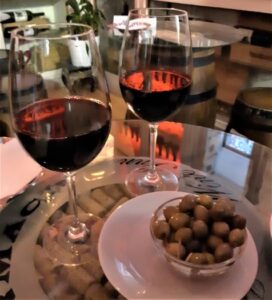
One of my favorite places in Bairro Alto is The Old Pharmacy. Just a five minute (and mostly flat) walk from Elevador Gloria, The Old Pharmacy is housed in, of course, an old pharmacy. But, instead of pills and elixirs, the glass cabinets are filled with old wine bottles and guitars. And instead of compounds and cotton balls, big glass jars are filled with old corks. Tables and chairs are converted wine barrels and the wait staff wears white jackets, making them look like pharmacists of old, adding to the charming atmosphere. In addition to a great selection of Portuguese wines, The Old Pharmacy has a nice selection of Petiscoes (Portuguese snacks or small plates). Highly recommended.
Lisbon Winery (see above) is a two minute walk from The Old Pharmacy.
Chiado
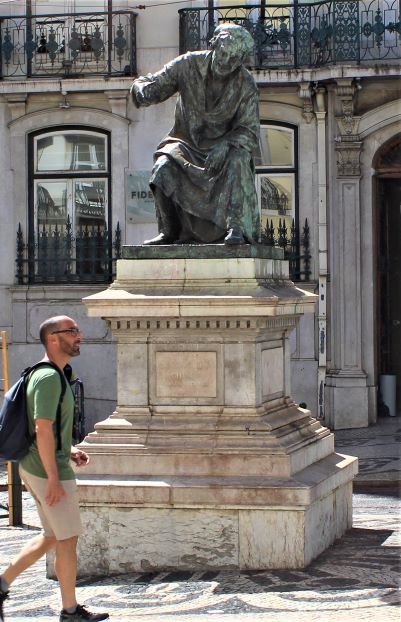
The fashionable Chiado district, with Chiado Square at its center, is also the bohemian heart of Lisbon. This is where you’ll find the Café A Brasileira (see above).
For many years this was also the home of António Ribeiro, Lisbon’s favorite poet, who was given the nickname Chiado (translates to Squeak) and, in turn, gave his name to the neighborhood.
There is a statue of Ribeiro in Chiado Square showing him with his arm raised as if the satirist is telling an amusing story.
Rua Garrett is the main street in Chiado and a great place to wander. In addition to Café A Brasileira, there are many characteristic shops. One of these is Livraria Bertrand, which bills itself at the oldest bookstore still in operation.
Little Wine Bar
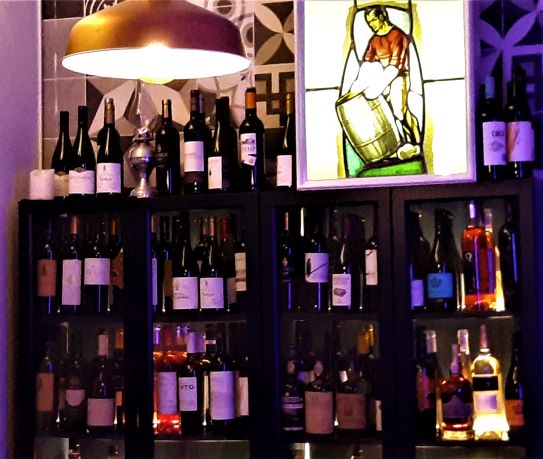
Karen and I were climbing flight after flight of stairs from the lower area near Avenida da Liberdade. At 192 stairs, yes I counted, a place caught my eye. Truthfully, Starbucks would’ve caught my eye at that point; I was sick of climbing stairs. But, this place looked good, Karen agreed, and we abandoned our upward march for a table at the Little Wine Bar.
The name is appropriate. The little place has about five tables and a tiny bar area. And the space is so cramped that you’re elbow to elbow with the folks at the table next to you. But, that only adds to the charm of the place. The couple next to us were from Abruzzo, Italy. They spoke a little English and with our (very) rudimentary Italian, we had a lovely conversation.
The owner of the Little Wine Bar suggested a few vintages for us and they were right on the mark. The food is pretty darn good as well.
A second location of the Little Wine Bar has recently opened, located not too far from the original.
Baixa Pombalina
In this lively area there are lots of restaurants, shops, and the busy Rossio Square. This is also where you’ll catch the Elevador da Gloria to Bairro Alto or stand in long lines for the Santa Justa Lift.
My favorite market, Mercado da Baixa, is in Baixa (see above). A great spot to grab provisions for a picnic. It’s also where the Ginjinha bars (see above) are located.
Praça do Comércio (Commerce Square)
While Rossio Square is full of life, the city’s grandest square is Praça do Comércio (Commerce Square). The area, including a royal palace, was reduced to rubble in the 1755 earthquake. King José I (Joseph I), became emotionally incapacitated after the natural disaster and developed a case of claustrophobia, never again living within the confines of the city. Instead, José I’s Prime Minister, the Marquis of Pombal, was tasked with the massive rebuild of Lisbon. In Commerce Square there is a statue of José I facing the river. But, if you enter the square through the huge portal, you see the intention of the monument. José I is facing the river, yes, but he is also facing away from Lisbon, symbolizing the king turning his back on the people of the city.
The Rossio Station in Baixa is where you’ll likely catch the train to Sintra. But don’t miss the Fado Statue outside.
Belem
Belem gets its name from the Portuguese word for Bethlehem. This district has some of the most popular and iconic attractions in the city. You’ll want to spend at least a half day to see everything.
My recommendation is to get a very early start. The riverfront along the Tagus is concrete and mostly treeless and gets hot, especially in the summer. Plus, many of the sites get inundated when buses bring cruise ship passengers to Belem.
The best way to get to Belem is by the Number 15 Tram. The 15 goes east from Baixa to Belem, but my favorite thing to do is get a Viva Viagem Card good for 24 hours of rides on the public transportation system and make a few stops along the way.
On a hill across the Tagus River is the 330’ concrete Christ the King Statue. The statue was built in 1959 by the Salazar dictatorship as thanks for sparing Portugal the horrors of World War II (but, unfortunately, not the horrors of Salazar’s brutal regime.) The statue was inspired by the similar Christ the Redeemer statue in Rio, Brazil.
To see the statue up close, and enjoy the spectacular views from the hill where it sits, take the Cacihas Ferry. Tram 15 stops at Cais do Sodré, which is a short walk to the Cacilhas Ferry. Best of all, the Cacihas Ferry is part of the public transport system, so it is covered by your Viva Viagem Card.
From there take the 101 or 101a bus up the hill to the statue. Alternatively, get an Uber.
If time is limited, take pictures of the statue from the Lisbon side of the river. It’s visible from practically everywhere in Belem.
25 de Abril Bridge
The 25 de Abril Bridge is the most famous landmark in Lisbon. It is often compared to the Golden Gate Bridge because of its design and color. Originally called the Salazar Bridge after the infamous Portuguese dictator, it was renamed the 25 de Abril Bridge after the Carnation Revolution restored democracy.
If you love taking pictures or making your friends jealous on Instagram, get off at the Santo Amaro stop on Tram 15.
MAAT (Museum of Art, Architecture and Technology)
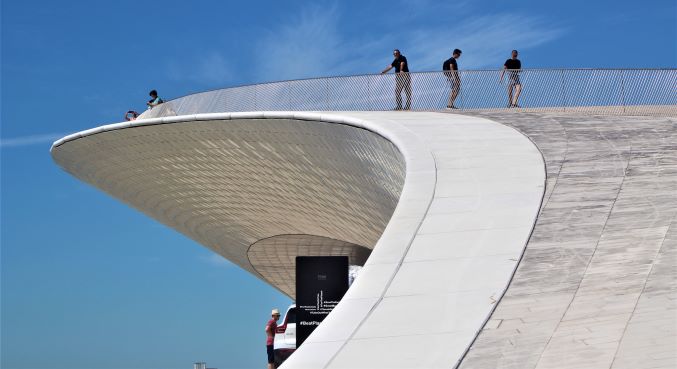
MAAT is right on the river and consists of two main buildings. The first is a gorgeous modern structure with a swoosh of a roof you can access by a gently sloping ramp. Great views up here.
The second building is the old Tejo Power Station. This building, uncommonly beautiful for an industrial structure, gives a look back at what the riverfront was like in the not too distant past. Inside, the power station has been renovated into a nice museum that tells the story of electricity from industrialization to sustainable energy.
The Belem stop on the 15 Tram is a short walk to MAAT.
Jerónimos Monastery
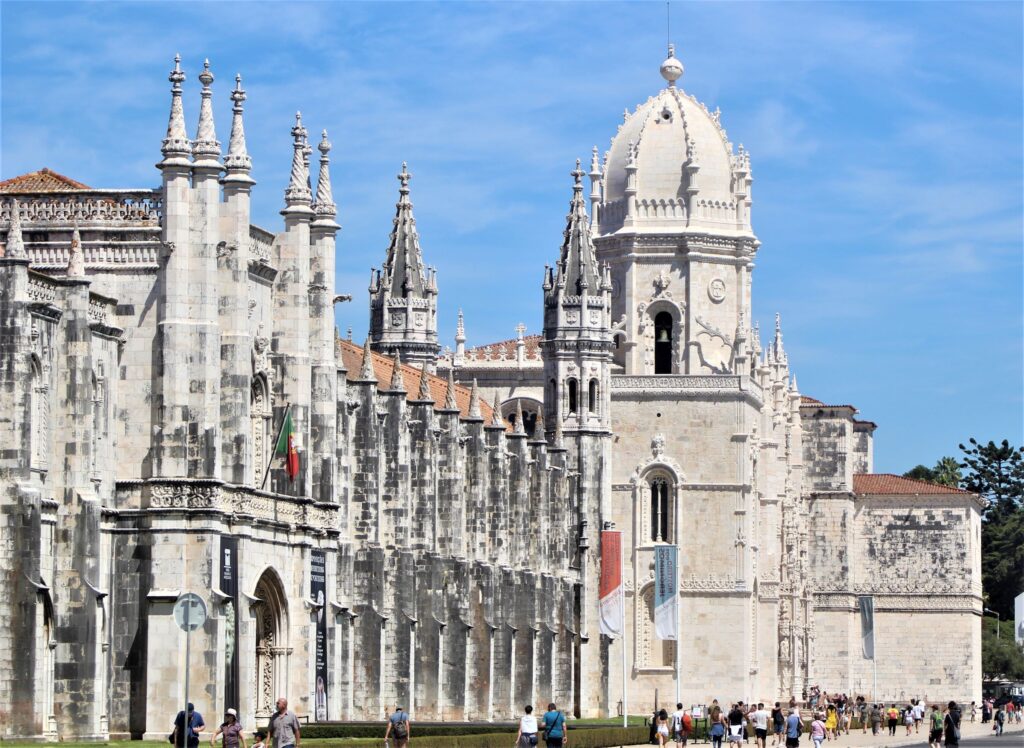
The ornate Gothic Jerónimos Monastery was built in the early 16th century with money from taxes on imported goods from Portugal’s far-flung empire. It’s easy to see how powerful Portugal was during this time by simply looking at the church’s facade. It could take a lifetime to inspect each of the beautifully carved figures and fanciful designs on the facade.
Inside is tomb of Vasco de Gama and a maritime museum inside (separate entrance fee). The Lisboa Card gets you free admission to the Jerónimos Monastery.
Visiting the Monastery is free (though you may have to wait in line to get in), but if you want to see the cloisters you have to buy a ticket. The cloisters are worth seeing for more spectacular stone work as well as the tile murals in the refectory.
Getting back on the tram after visiting MAAT and taking the 15 Tram to the Mosteiro dos Jerónimos stop is an option. But, the waterfront makes for a nice stroll from MAAT to the Monument to the Discoveries and then across the street to the Jerónimos Monastery.
Fábrica de Pastéis de Belém
After all that culture and history, it’s time for a snack. Literally just across the street from the Jerónimos Monastery is Fábrica de Pastéis de Belémin. They started selling Pastel de Belém (only Fábrica de Pastéis de Belém can call them Pastel de Belém, everyone else has to call the treat Pastel de Nata) in 1837. Lines can be long, but if you don’t want to wait, go inside and be seated at a table. Some Lisboetas call these pastry the best in the city.
Monument to the Discoveries (Padrão dos Descobrimentos)
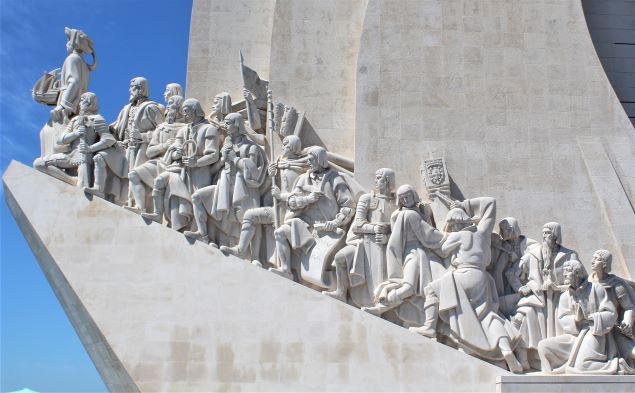
Built as a temporary structure during the Portuguese World Exhibition in 1940, the original monument was destroyed in 1943. A permanent Monument to the Discoveries was constructed from 1958-1960 and was based on the original structure. The new Monument to the Discoveries was dedicated in 1960 to commemorate the 500th anniversary of the death of Henry the Navigator.
The massive structure depicts the bow of Portuguese sailing ship with 33 statues of famous Portuguese navigators, political figures, and royalty headed by Henry the Navigator. Surprisingly, to me at least, Vasco de Gama recieves a subordinate position on the eastern side of the monument.
Tickets can be purchased to go to the top of the monument which affords great views. But, if you don’t want to wait in line or pay for a ticket, the roof of the MAAT offers nice views as well and is free.
Parque das Nações
Parque das Nações is a neighborhood that is often overlooked by visitors because it is modern, rather than traditional. But, this new area of the city, reclaimed from an industrial wasteland is definitely worth your time.
Parque das Nações origin story
Parque das Nações (Park of Nations) is a gorgeous waterfront neighborhood in Lisbon. Prior to 1998, it was an ugly area of slaughterhouses and polluting factories no tourist would have any reason to visit. That changed when Lisbon was chosen to host the Expo ’98, aka the 1998 Lisbon World Exposition.
Building on the newly purposed area from scratch, a metro line was added to reach the neighborhood as was a state of the transportation center (Oriente). In addition, the Vasco de Gama Bridge, the longest in Europe, was built to give access to the Setubal peninsula across the Tagus River.
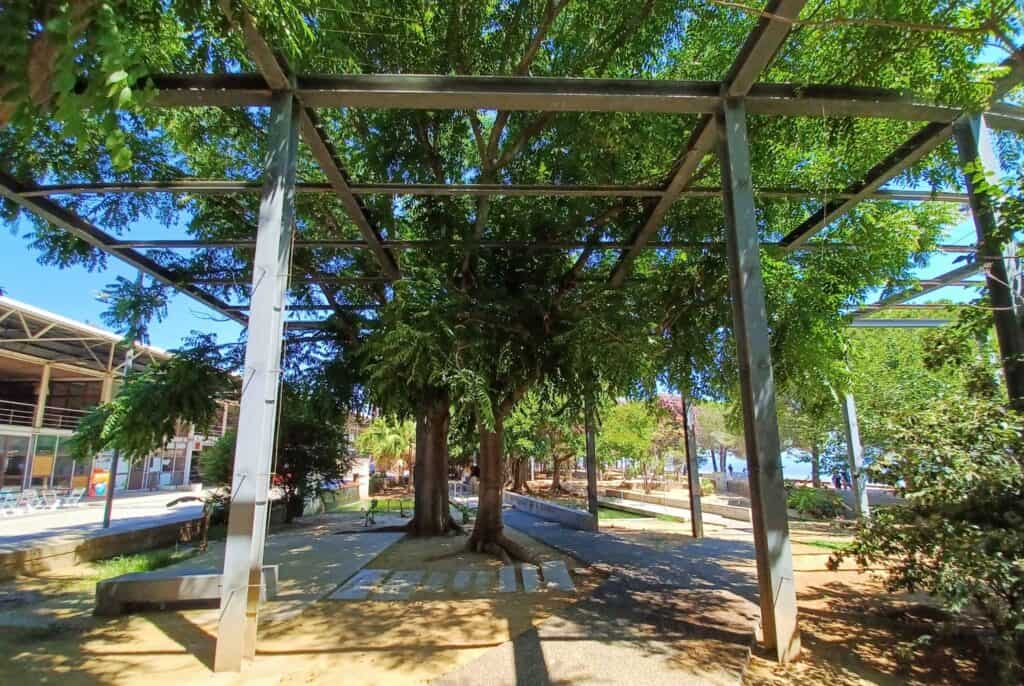
After Expo ’98, the buildings for the event were removed leaving a huge parcel of prime real estate right on Lisbon’s waterfront. This was rebuilt as the new Parque das Nações neighborhood.
Modern buildings along with a world-class aquarium (at the time the largest in Europe), a cable car funicular, mini parks, and a waterfront promenade made Parque das Nações stand out as an almost futuristic neighborhood in stark contrast with the charming historic neighborhoods of Lisbon.
Things to do in Parque das Nações
You can easily spend half a day in Parque das Nações, but if you have the time and want to see the aquarium, a full day would be time well spent.
Promenade
My favorite thing to do at the Parque das Nações is to walk along the waterfront on the promenade. From there you get amazing views of the Vasco da Gama Bridge, the Tagus River, the cablecar funicular, and the modern buildings in the neighborhood.
There’s also several mini parks along with walk filled with shady trees and other plants along with places to sit and relax. The most interesting pocket park is the Jardim Garcia de Orta which is filled with flora from exotic Portuguese islands like the Azores and Madeira as well as former colonies like Goa (India), Brazil, Macau, Cape Verde, and São Tomé.
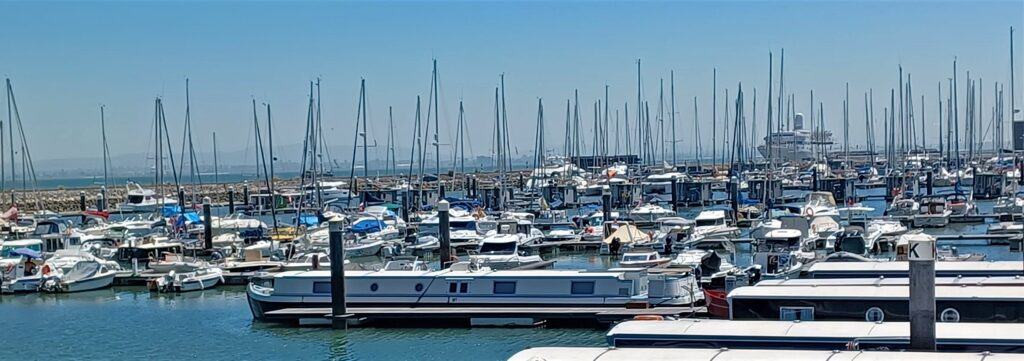
Cable Car
For the best views of Parque das Nações, take the Telecabine Lisboa (Cable Car). You can ride roundtrip on the Telecabine, but I like to start at the Telecabine South Station and buy a one way ticket. You’ll ride over Parque das Nações for about a mile and be dropped off at the North Station.
From there, you’re right next to the Oceanário de Lisboa (Aquarium) or, for some adult fun, walk to the Casino Lisboa. Walking back, there’s a lovely boardwalk revealing some spectacular views of Parque das Nações.
Public Art
There’s several spots to see outdoor works of art in Parque das Nações. A couple of the most striking, a sculpture of a cat called “Iberian Lynx” by artist Bordalo II and Rizoma by Antony Gormley are in Rossio dos Olivais where the flags of the nations are displayed. It’s fun to look at the long line of banners and see how many you can identify.
Places to eat in Parque das Nações
Since Parque das Nações is a residential neighborhood (over 30,000 people live here), there are several good places to eat. At the very top end is Fifty Seconds, a restaurant sporting a coveted Michelin star. The location is also incredible being on the top of the Vasco da Gama tower in the Myriad Hotel. The space resembles the crow’s nest of a sailing ship giving a nod to Portugal’s sea faring heritage. Fifty Seconds is a big splurge with the tasting menu running about 200 bucks and appetizers starting at about 50. But, oh, those views.
Nearby is another architectural gem, the Torre Vasco da Gama (Vasco da Gama Tower). These twin buildings resemble sails fully unfurled and are a striking part of the skyline. Sadly, they are residential buildings so you can’t visit unless you live there or know someone who does.

Tiles
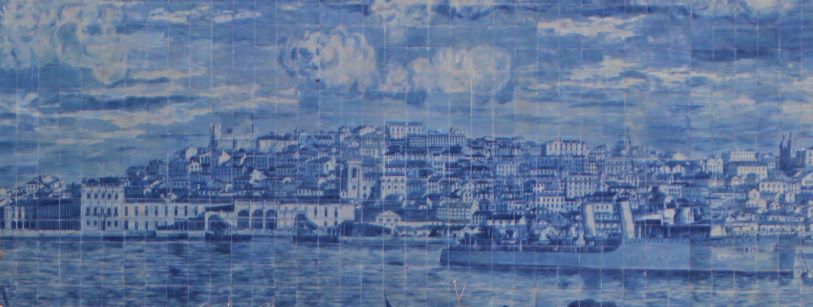
For more about the cultural importance of tiles in Portugal, check out my Porto post.
The distinctive tiles of Portugal, called Azulejos were introduced to the Iberian Peninsula from North Africa by the Moors. Popularized in Portugal when King Manuel I visited Seville, saw the tiles there, and decided to decorate his palace with the colorful Azulejos in the early 16th century.
Early Azulejos were geometric in design which kept with the Muslim tradition of not depicting people or animals. But, with the Renaissance, Azulejos came to show both people and animals, mostly in Biblical settings.
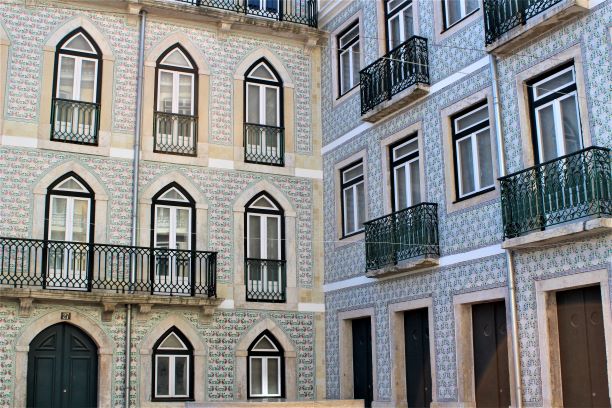
Sadly, during the early 20th century, Azulejos were looked down upon as a style of the lower classes and many great Azulejo installations were destroyed.
Then, when Lisbon built its underground metro system in the 1950s, something wonderful happened. Artists decorated the stations with Azulejos and suddenly the tiles became popular once again.
To see Azulejos, you can visit one of the many metro stations decorated with them. Gare do Oriente (Lisbon Oriente Station) has some fine examples.
Many apartment buildings have Azulejo facades with colorful geometric designs.
There is even a National Museum of the Azulejo (Museu Nacional do Azulejo) with the largest collection of Azulejos in the world. The setting of the museum is stunning as well. It’s in the 16th century Convento de Madre Deus and the chapel would be worth visiting for the ornate decoration alone.
Be sure not to miss the Grande Panorama de Lisboa on the top floor of the museum. This awe-inspiring work of azulejo tiles shows the skyline of Lisbon. It was completed before the 1755 earthquake so many of the building depicted on the mural are no longer standing. The most important structures are labeled so you can follow along as you walk the length of the masterpiece and see buildings you may know and others that are long gone.
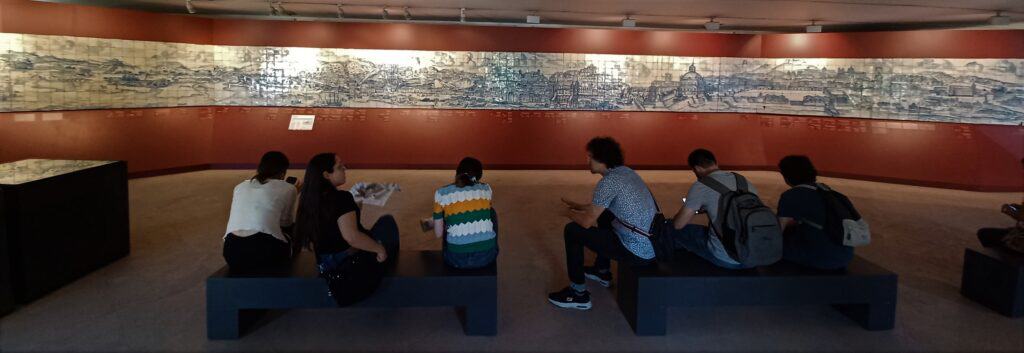
But, my favorite spot for Azulejos is Miradouro de Santa Luzia. This small square and garden doesn’t have the most beautiful Azulejos (not that they’re ugly). However, the setting, with a deck overlooking the river, is spectacular, making the Azulejos even more wonderful.
Daytrips
Sintra
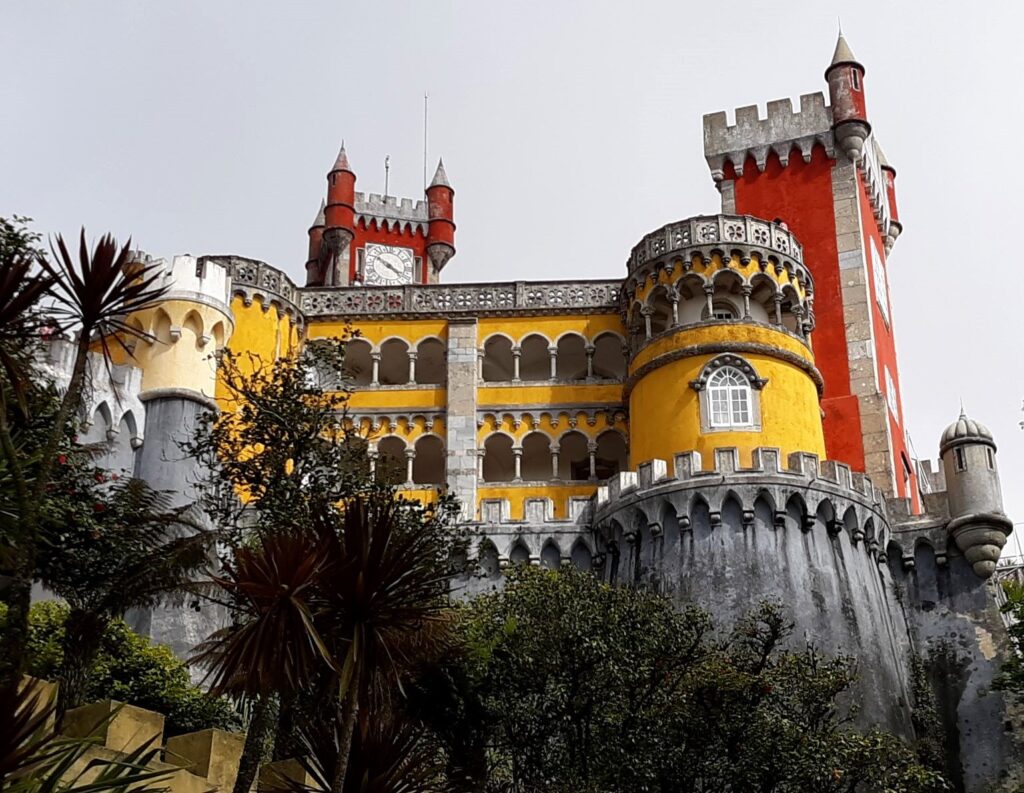
Sintra is the most popular daytrip destination from Lisbon for good reason; its concentration of castles and palaces.
To get to Sintra, you can take the train from Rossio Station. It takes about 40 minutes and is faster than the bus. Don’t think about driving, the roads are tough and there’s almost zero parking in Sintra.
Besides the must-see Pena Palace and Moorish Castle there are delicious treats to try in Sintra. I’ve written a complete Foodie Travel Guide and posted a video about Sintra.
Évora
Évora escaped the damage of the 1755 earthquake that leveled Lisbon and, therefore, is one of the best preserved Medieval towns in Portugal.
Trains depart Santa Apolónia Station and Gare do Oriente a few times a day. It’s 2+ hours from Santa Apolónia and 90 minutes from Oriente to Évora. Advance tickets can be purchased online.
Some of the top sites are the Chapel of Bones and Cathedral in Évora. There’s also top notch wine produced in the area and amazing Convent Sweets. Here’s a link to my complete Foodie Travel Guide to the city. I’ve also made a couple videos about Évora.
Coimbra
Coimbra is about halfway between Porto and Lisbon, making it a great stopping point if traveling to both cities, or an easy day trip from Lisbon.
The University of Coimbra has 20,000 students making the former capital city of Portugal lively and exciting.
There are frequent trains from Santa Apolónia Station and Gare do Oriente in Lisbon to Coimbra. Note that trains from Lisbon stop at Coimbra B Station which is a mile uphill walk to the city center. Better to take a local train from Coimbra B to Coimbra A or grab a cab outside the station.
The library, Biblioteca Joanina, is definitely worth a visit. Coimbra also has its own Fado culture with men doing most of the singing. Coimbra has it’s own special pastry called Pastel de Santa Clara.
Transportation
Lisbon Portela Airport (LIS)
Non-stop flights to Europe, the Middle East, north Africa, North America, and China. Metro, bus, shuttle, taxi, and Uber connect to the city.
Alameda das Comunidades Portuguesas, 1700-111 Lisboa, Portugal
Train
CP is the main operator of trains connecting Lisbon and other cities in Portugal and the rest of Europe. Clean and reliable.
Viva Viagem Card
Load up this card with Euros and save big on Metro, Bus, Trolley, Ferry and Funicular rides. Essential.
24 Hour Card
An excellent value if you’re only using public transport for one day.
Tram
Lisbon’s iconic trams are part of the public transportation system. Get a Viva Viagem Card and zap in/zap out when you ride.
Index of Things to Do in Lisbon
Lisbon Walker
Several excellent group and private walking tours.
Inside Lisbon
Walking and food and wine tours.
Lisbon Chill-Out Free Tour
Walking tour is free but always tip your guide at the end.
Praça Luís de Camões, 1200-243 Lisbon, Portugal
Culinary Backstreets
Well-curated tour of some hidden gem spots.
Devour Tours
Food-centric tour of Lisbon.
Santa Justa Lift
Fun way to get from the Baixa neighborhood to Barrio Alto. Often has long lines.
Rua do Ouro, 1150-060 Lisbon, Portugal
Museu Arqueológico do Carmo (Carmo Archaeological Museum)
Ruins of the Carmo Convent, abandoned after the 1755 earthquake. Now a museum.
Largo do Carmo, 1200-092, Lisbon 1200-092, Portugal
Estufa Fría
Greenhouse and garden of exotic plants on the grounds of a former stone quarry.
Parque Eduardo VII, 1070-051 Lisboa, Portugal
Lisbon Cathedral
First church built in Lisbon after the Moors were pushed out.
Largo da Se, Lisbon 1100-585, Portugal
Praça do Comércio
Huge historic square on Lisbon’s riverfront.
Praça do Comércio, 1100-148 Lisbon, Portugal
Museu Nacional do Azulejo (National Tile Museum)
Fantastic collection of tiles in a 16th century monastery.
R. Me. Deus 4, 1900-312 Lisboa, Portugal
Museu Nacional de Arte Antiga (Museum of Ancient Art)
Not ancient art, but instead a huge collection from the “Age of Discovery.”
Rua das Janelas Verdes, Lisbon 1249-017, Portugal
Museu Do Aljubel (Museum of the Resistance)
Museum dedicated to the rise and fall of Fascism (and its leader Antonio Salazar) in Portugal.
R. Augusto Rosa 42, 1100-059 Lisbon, Portugal
History of Lisbon Mural
Colorful mural showing the history of Lisbon in comic book form.
Beco de Santa Helena 25, 1100-117 Lisboa, Portugal
Maria da Mouraria – Casa de Fados
Former home of Maria Severa Onofriana, a famous Fado singer. Now a restaurant with Fado performances. Cash only.
Largo da Severa 1 e 2, Largo Severa 2, 1100-588 Lisboa, Portugal
Miradouro de Santa Luzia
Beautiful views, great tile murals.
Largo de Santa Luzia, Alfama, Lisbon 1100-487, Portugal
Igreja de Santo António de Lisboa (Church of St. Anthony)
Church dedicated to the patron saint of Lisbon. Supposedly located on the site of Anthony’s childhood home.
Largo de Santo António da Sé, 1100-401 Lisboa, Portugal
Memorial to the Victims of the 1506 Massacre of Jews
Small memorial to the Jews killed in Lisbon in 1506. The square is also the site of a slave market.
Largo de Sao Domingos, Lisbon 1150-320, Portugal
Museu do Fado (Fado Museum)
All about the history of Fado. Occasional performances.
Largo do Chafariz de Dentro 1, Lisbon 1100-139, Portugal
National Coach Museum
Museum of over-the-top royal coaches.
Av. da Índia 136, 1300-004 Lisboa, Portugal
Jerónimos Monastery
Ornate Gothic monastery with an impressive facade. Inside is tomb of Vasco de Gama. There is also a maritime museum inside (separate entrance fee).
Praça do Império 1400-206 Lisboa, Portugal
Padrão dos Descobrimentos (Monument to the Discoveries)
Massive monument to Henry the Navigator and other Portuguese explorers.
Avenida Brasilia, Belem, Lisbon 1400-038, Portugal
Parque das Nações
Gorgeous redeveloped area along the Tagus River.
Telecabine Lisboa (Cable Car)
Cable car overlooking the Parque das Nações neighborhood.
https://www.google.com/maps/search/Telecabine+Lisboa/@38.7679355,-9.0962133,16z/data=!3m1!4b1
Bordallo Pinheiro Garden
Garden populated with crazy porcelain sculputres by artist Bordallo Pinheiro.
Campo Grande 245, 1700-162 Lisboa, Portugal
Cacilhas Ferry
Commuter ferry to reach Cacilhas. Bus or Uber from there to Cristo Rei statue.
R. da Cintura do Porto de Lisboa, 1249-249 Lisboa, Portugal
Cristo Rei Statue (Christ the King)
330 statue inspired by the one in Rio. Spectacular views!
Praceta do Cristo Rei 27, Almada 2800-058, Portugal
Index of Food & Drink in Lisbon
Belcanto
Two Michelin starred dining experience from chef Jose Avillez.
R. Serpa Pinto 10A, 1200-026 Lisbon, Portugal
Ao 26 Vegan Food Project
Not just great vegan food, great food period.
Rua Vitor Cordon 26, Lisbon 1200-484, Portugal
The Food Temple
Hip, vegan eatery in the Mouraria neighborhood. Outstanding. Reservations essential.
Beco do Jasmim 18, 1100-289 Lisboa, Portugal
The Old Pharmacy
Great spot for wine and small bites in Bairro Alto
Rua do Diário de Notícias 73, Lisbon, Portugal
Terra
Vegetarian take on Portuguese dishes.
Rua da Palmeira 15, Lisbon 1200-311, Portugal
daterra
Vegan buffet chain in Portugal.
Av. Dom João II 25A, 1990-079 Lisboa, Portugal
Roda Viva
Terrific Mozambique cuisine in Alfama. Worth seeking out!
Beco do Mexias 11 R/c, 1100-349 Lisboa, Portugal
Kong
Vegan takes on Portuguese classics in a casual atmosphere.
R. do Crucifixo 30, 1100-183 Lisboa
Green Affair
Tasty vegetarian restaurant.
R. Serpa Pinto 15A, 1200-443 Lisboa
Manjerica
Good veg. breakfast spot near Rossio Square.
Rua João das Regras, Praça da Figueira 5-A, 1100-293 Lisboa, Portugal
Vegan Nata
Pastelaria with vegan pastel de nata.
R. 4 de Infantaria 29 B, 1350-268 Lisboa
A Primavera do Jeronimo
Lisbon home cooking. Always busy. Very limited veg. options.
Travessa da Espera 34, Lisbon 1200-176, Portugal
Manteigaria
Great place to get Pastel de Nata.
Rua do Loreto 2, Largo de Camões, Lisbon 1200-242, Portugal
Vegan Story
Vegan restaurant in Parque das Nações. Menu changes daily. Excellent desserts as well.
R. Cais das Naus 12A, 1990-304 Lisboa, Portugal
Alcoa
Nice pastry shop.
Rua Garrett 37, 1200-309 Lisbon, Portugal
Cafe A Brasileira
Coffee bar famous for the writers and intellectuals who hung out here in 1910’s and 1920’s. Now tourists and students do.
Rua Garrett 120, Lisbon 1200-205, Portugal
Cafe Tofa
Little cafe that serves Amendoa.
Rua Coreto 33, 1200-241 Lisbon, Portugal
Carmo
Petiscos (tapas) and full meals are delicious.
Largo do Carmo 11, Lisbon 1200-092, Portugal
Lisbon Winery
Not only the best wine bar in the city, but good cheese pairings with Fado music often playing in the background.
Rua Rodrigues Sampaio, 18 A, 1150-280 Lisbon
Tambarina
Cape Verde restaurant with simple dishes and grogue (Cape Verdean firewater).
Rua do Poco dos Negros 94, Lisbon 1200-341, Portugal
Pavilhão Chinês
Is this a bar or a museum of kitch? Either way, it’s good fun. Ring the bell to get in.
R. Dom Pedro V 89, 1250-093 Lisboa, Portugal
Jardim dos Sentidos
Vegetarian place with a lunch buffet and a great deal on Tuesday for dinner. Three courses with wine for 36 Euro.
Rua Mae D’Agua 3, Lisbon 1250-154, Portugal
Leitaria Baiana
Small restaurant with a good wine selection including several excellent ports.
61,, Av. da Liberdade 59, Lisboa
Pasteis de Belem
The first commercial bakery to make Pastel de Nata. Same family still runs it.
Rua de Belem No 84 a 92, Lisbon 1300-085, Portugal
Organi Chiado
Small vegan restaurant with outstanding food. The rice flour bread is special.
Calçada Nova de São Francisco 2, 1200-300 Lisboa, Portugal
O Corvo
Nice restaurant with aguardente bagaçeira (firewater) cocktails.
Largo dos Trigueiros 15A-15B, Mouraria, Lisbon 1100-611, Portugal
Cozinha Popular
All-inclusive inexpensive restaurant using local produce.
Rua das Olarias 5, Lisbon 1100-377, Portugal
Pastelaria Santo Antonio
Voted best Pasteis de Nata.
Rua Milagre de Santo António 10, 1100-351 Lisbon, Portugal
Baltazar Roiz Castanheiro Sucessor
Oldest coffee shop in Lisbon, since 1829. Amazing interior decor.
da, Pç da Figueira 18B, Lisboa, Portugal
Café Martinho da Arcada
Been doing it since 1782.
Praca do Comercio 3, Lisbon 1100-148, Portugal
Restaurante Bastardo
Restaurant in the Internacional Design Hotel. Unique takes on classic dishes.
Rua Betesga 3, Lisbon 1100-090, Portugal
Boutique Taberna
Funky spot for sangria and music.
Escadinhas Sao Cristovao 8, Lisbon 1100-512, Portugal
Restaurante Laurentina o Rei do Bacalhau
The place for Bacalhau à bras.
Avenida Conde de Valbom 71 A, Lisbon 1050-067, Portugal
Restaurante A Floresta da Estefania
Family-run, no-frills with great food.
Rua Cidade da Horta 39, Lisbon 1000-101, Portugal
A Ginjinha
Tiny place to get a Ginjinha. Great atmosphere.
Largo São Domingos 8, 1100-201 Lisbon, Portugal
Ginjinha Sem Rival
Great place for a Ginjinha. Been in business since 1890.
R. das Portas de Santo Antão 7, 1150-264 Lisbon, Portugal
Little Wine Bar
Cozy with excellent food and wine. 2 locations.
Calcada do Duque 39, Lisbon 1200-155, Portugal
Tágide
Restaurant with a small but nice bar.
Largo da Academia Nacional de Belas Artes 20, Lisbon 1200-005, Portugal
Do Vigario Pub and Records
Bar with vegan tapas and a small record shop selling vinyl.
R. do Vigário 74, 1100-616 Lisboa, Portugal
By The Wine
Sleek wine bar with excellent choices.
Rua das Flores 41-43, Lisbon 1200-193, Portugal
Quimera Brewpub
18th century underground brewpub.
Rua Prior do Crato 6, Alcântara, Lisbon 1350-261, Portugal
Dois Corvo
Craft brewery with several options on tap and food.
R. Cap. Leitão 94, 1950-052 Lisboa, Portugal
MUSA
Taproom
Rua do Acucar, 83, Lisbon 1800-022, Portugal
Cerveja Lince
Lisbon microbrewery.
R. Cap. Leitão 1b, 1950-049 Lisboa, Portugal
Index of Shopping in Lisbon
Mercado da Ribeira (aka Time Out Market)
Huge food hall with a few produce stands.
Av. 24 de Julho, 1200, Lisbon 1200-481, Portugal
Cork and Co.
Everything you can imagine made of cork and then some.
Rua Salgadeiras 10, Lisbon 1200-396, Portugal
A Vida Portuguesa
Store offering Portuguese homegoods.
Rua Anchieta 11, Lisbon 1200-023, Portugal
Livraria Bertrand
World’s oldest bookstore still in operation.
R. Garrett 73-75, 1200-203 Lisbon, Portugal
Casa das Velas Loreto
Candle shop has been in the same family for seven generations since it opened in 1789.
Rua do Loreto 53, 1200-241 Lisboa, Portugal
Mercado do Jardim, Crafts and Design Market
Great market for one of a kind souvenirs. Open first weekend of the month.
12 Praça da Estrela, Lisboa, Lisboa, 1200-694, Portugal
Chocolataria Equador
Chocolate shop with several single-origin offerings.
Rua da Prata 97, 1100-414 Lisboa
Pelcor
High end cork shop with shoes, bags, and more made of cork. Online only.
LX Factory
Trendy outdoor market.
Rua Rodrigues de Faria 103, Lisbon 1300-501, Portugal
Cortiço & Netos
Place for authentic azulejos (tiles).
R. Maria Andrade 37D, 1170-215 Lisboa, Portugal
Mercado da Baixa
Outdoor food market busy with locals.
Praca da Figueira 10-B, Lisbon 1100-241, Portugal
Livraria Simão
Tiny, tiny bookstore only fits one person at a time.
Escadinhas de São Cristóvão, 18, 1100-511 Lisbon, Portugal
Feira da Ladra
Lots of junk at this flea market with the occasional find. Open Tuesdays and Saturdays.
Campo de Santa Clara | Alfama, Lisbon 1100-471, Portugal
Fabrica Sant’ Anna
High quality tile reproductions.
Calçada da Boa Hora 96 1300, 1300-488 Lisboa, Portugal
d’Orey Azulejos
Authentic antique colored tiles.
Rua do Alecrim 68, 1200-213 Lisbon, Portugal
Salão Musical de Lisboa
Taking up Fado? Get your guitar here.
Largo do Carmo, Rua da Oliveira ao Carmo 2, 1200-309 Lisboa, Portugal
Mercado Biológico do Príncipe Real
Saturday farmers market. Organic produce.
Praça do Príncipe Real, 1250-096 Lisboa, Portugal
Mercado de Campo de Ourique
Smaller but still very good food hall.
Rua Coelho da Rocha | Campo de Ourique, Lisbon 1350-075, Portugal
Index of Places to Stay in Lisbon
Heritage Avenida Liberdade
Contemporary hotel in the Avenida da Liberdade area.
Av. da Liberdade 28, 1250-145 Lisbon, Portugal
Figueira
Baixa hotel near the lively Placa da Figueira.
Praça da Figueira 16, 1100-241 Lisbon, Portugal
Pestana CR7 Lisboa
Reasonably priced hotel in the Baixa district.
Rua do Comércio 54, 1100-150 Lisbon, Portugal
Teatro B&B
Opulent B&B with a theatrical motif.
Rua Trindade 36, 1200-468 Lisboa, Portugal
Patio Sao Vicente
Adorable cottage apartments.
Telheiro de Sao Vicente 10 Portas Abcd, Lisbon 1100-620 Portugal
Torel Palace
Hotel is in two historic mansions on a nice hilltop locations.
Rua Camara Pestana no 23, Lisbon 1150-082 Portugal
About the Author

Brent Petersen is the Editor-in-Chief of Destination Eat Drink. He currently resides in Setubal, Portugal. Brent has written the novel “Truffle Hunt” (Eckhartz Press) and the short story collection “That Bird.” He’s also written dozens of foodie travel guides to cities around the world on Destination Eat Drink, including in-depth eating and drinking guides to Lisbon, Porto, Monsaraz, and Batalha. Brent’s podcast, also called Destination Eat Drink, is available on all major podcasting platforms and is distributed by the Radio Misfits Podcast Network.


